This document provides an overview of working with databases and MySQL. It discusses database concepts like tables, records, fields, primary keys, and relationships. It also covers MySQL topics such as creating and selecting databases, defining tables, adding/retrieving/updating/deleting records, and modifying user privileges. The goal is to teach the basics of working with databases and the MySQL database management system.
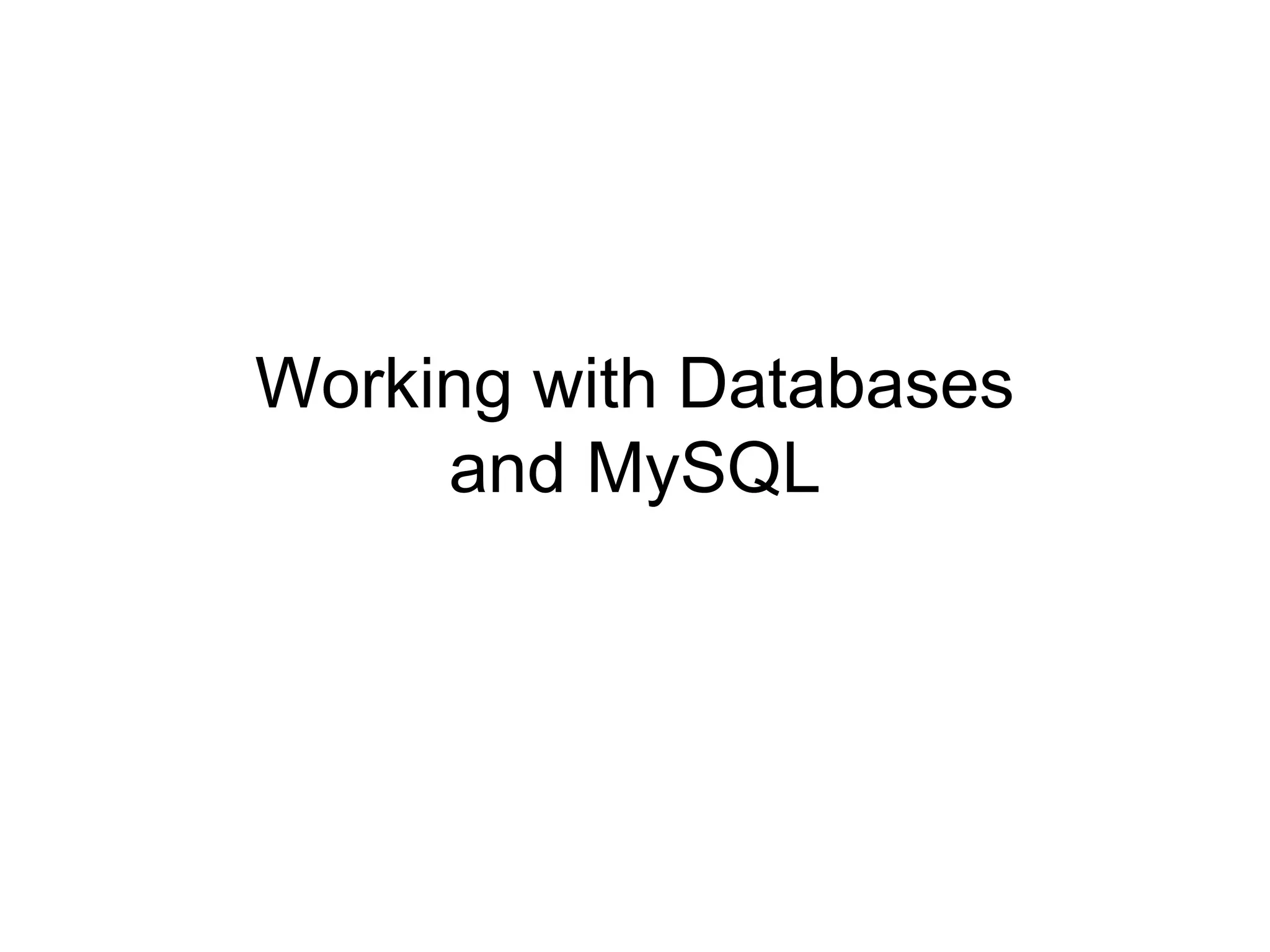
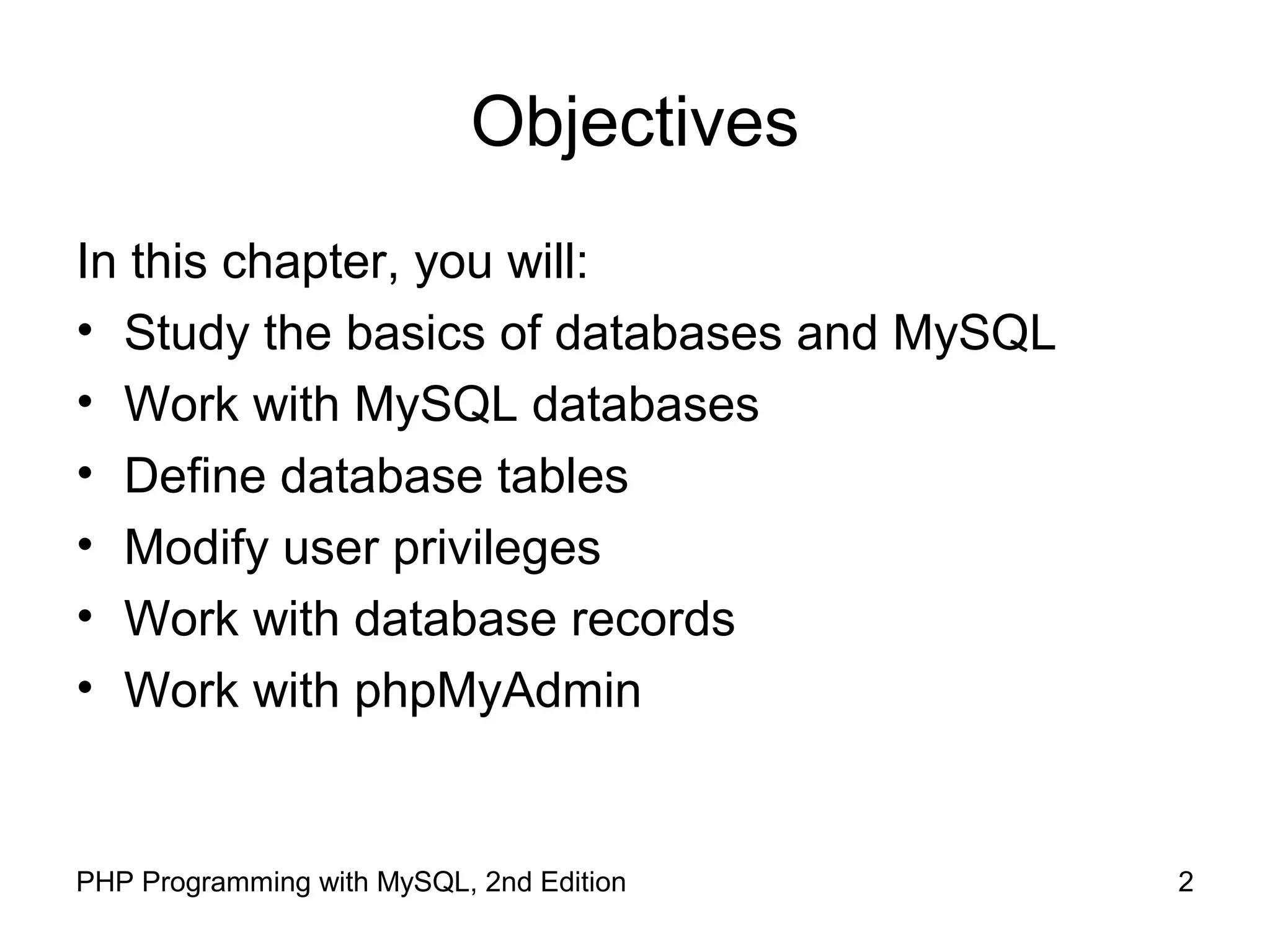
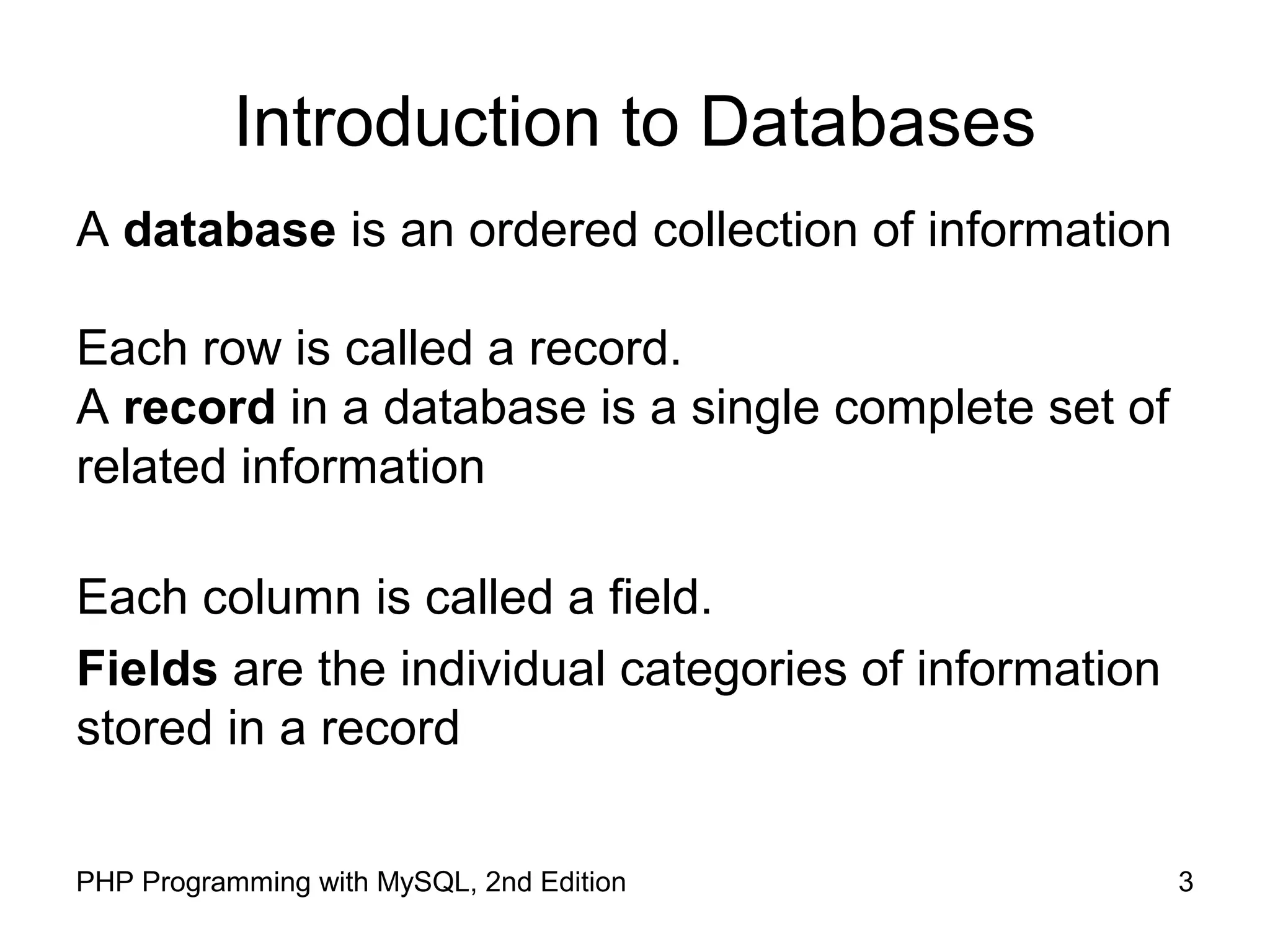
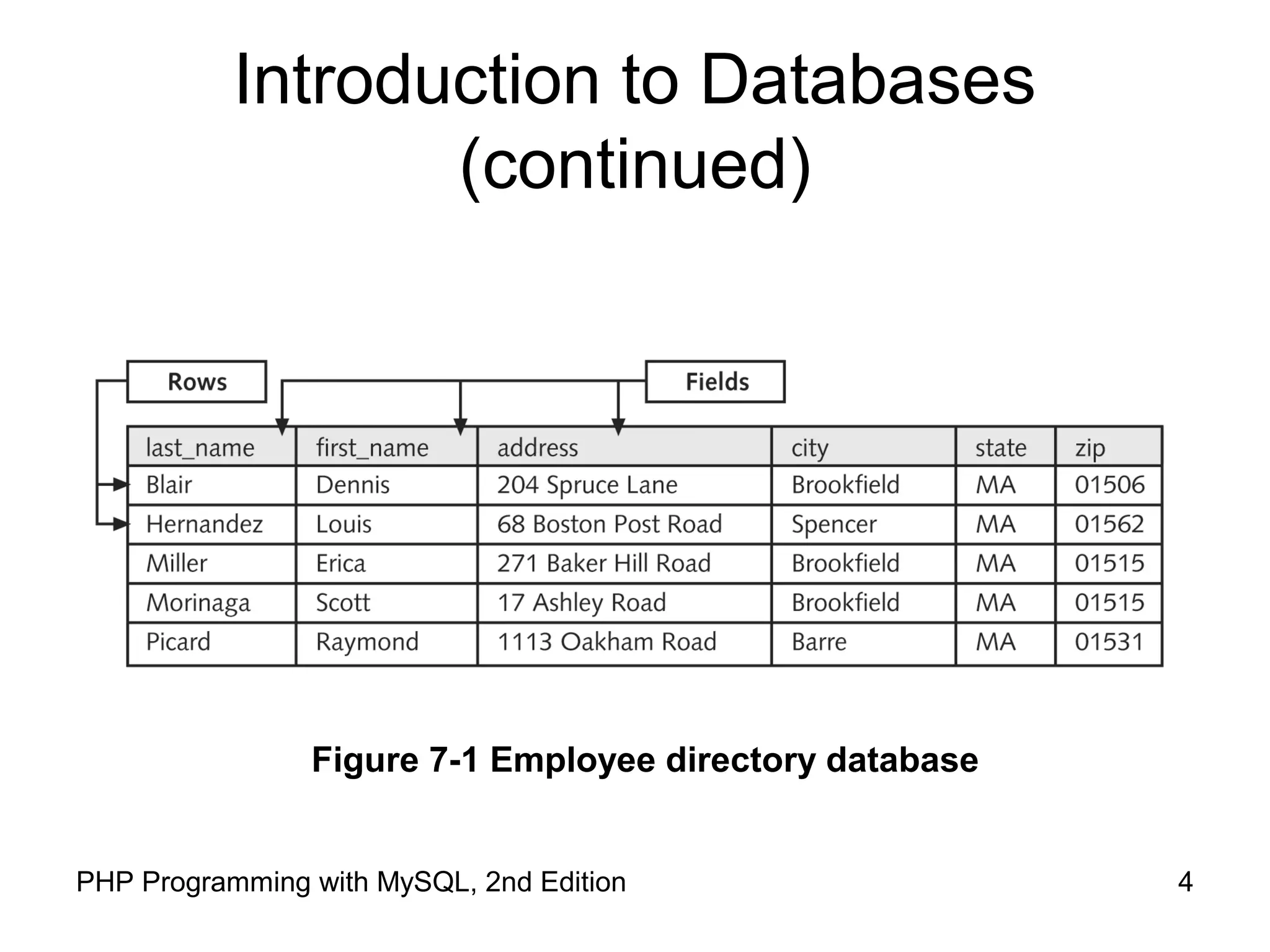
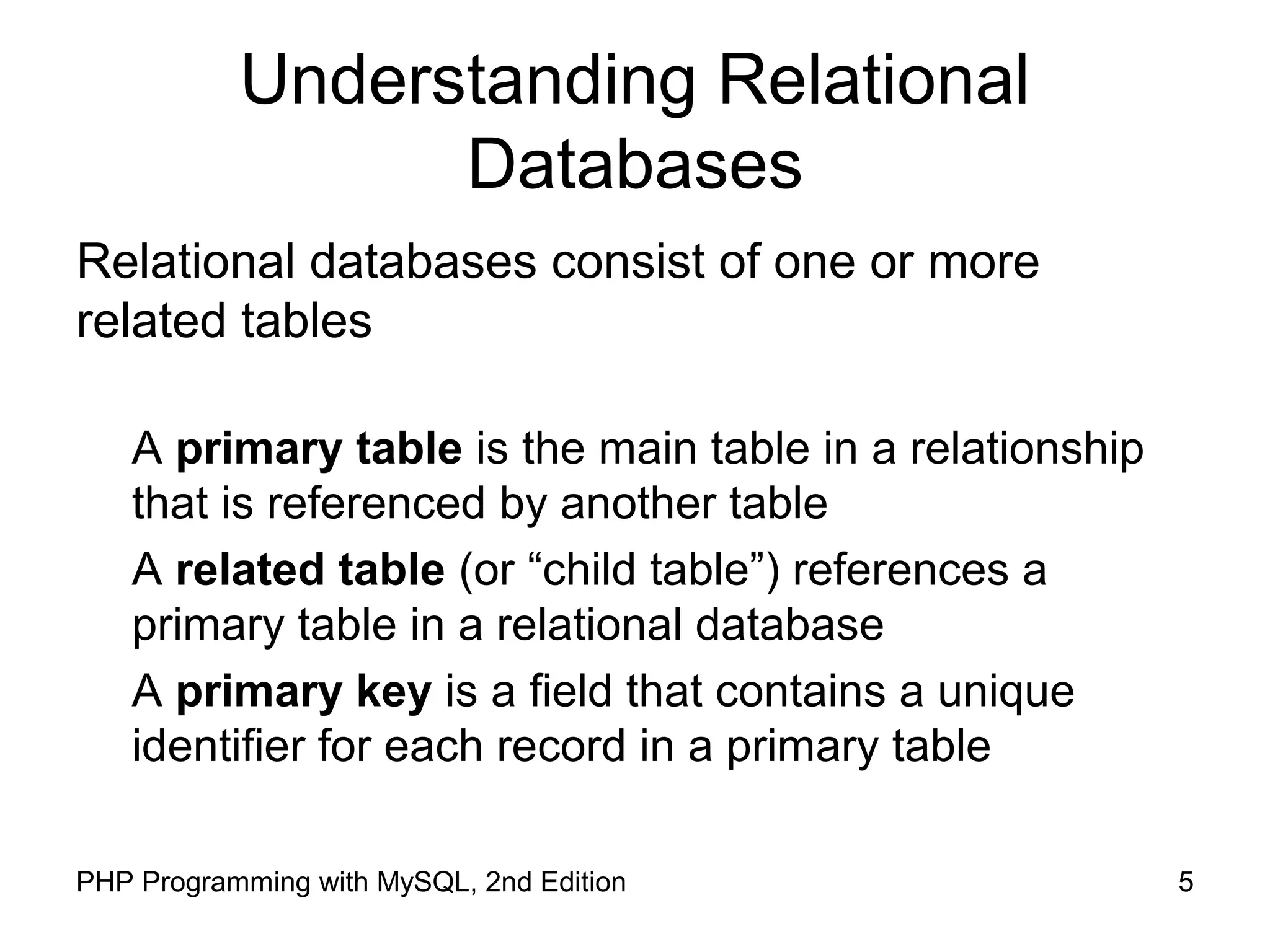
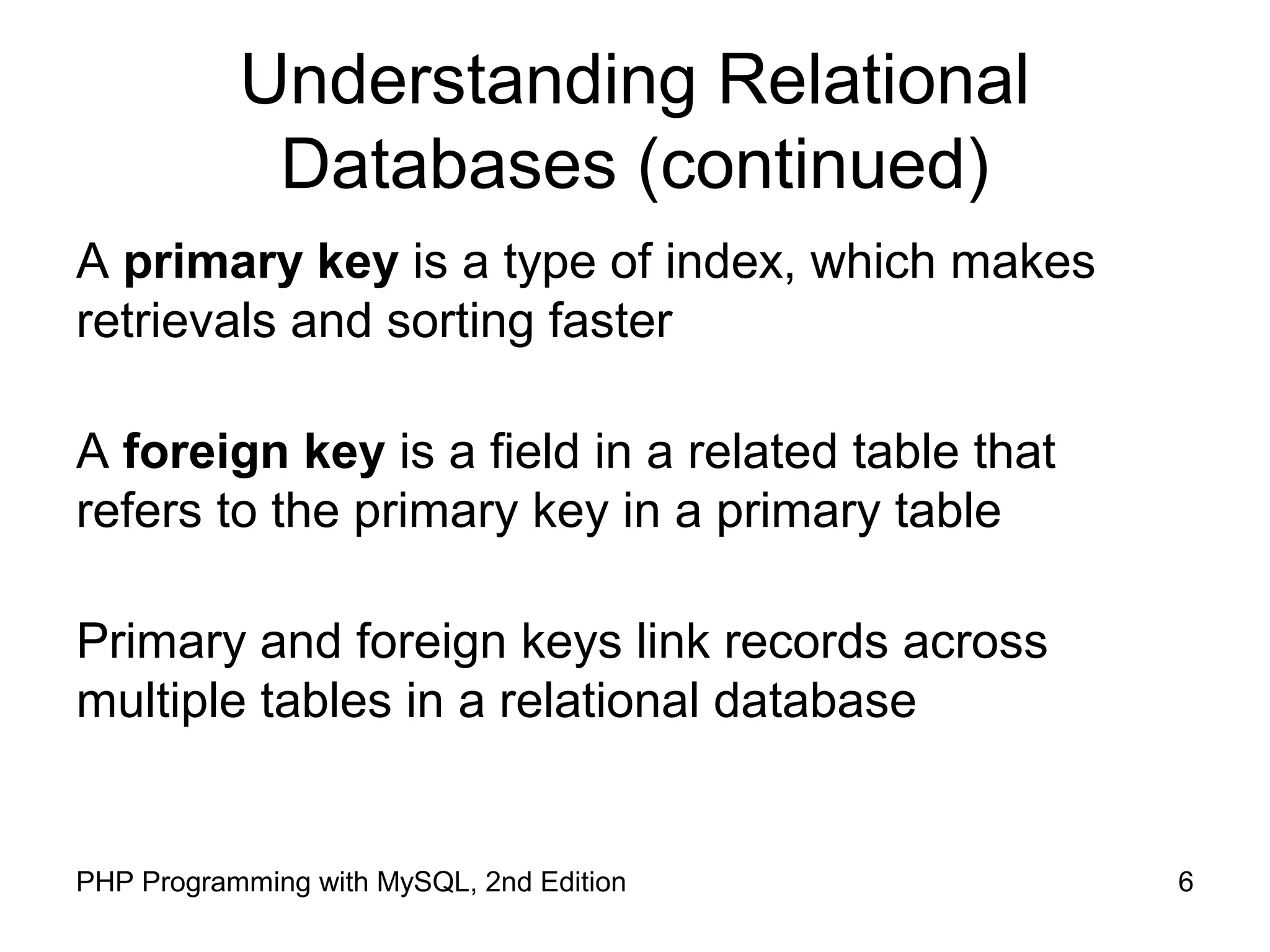
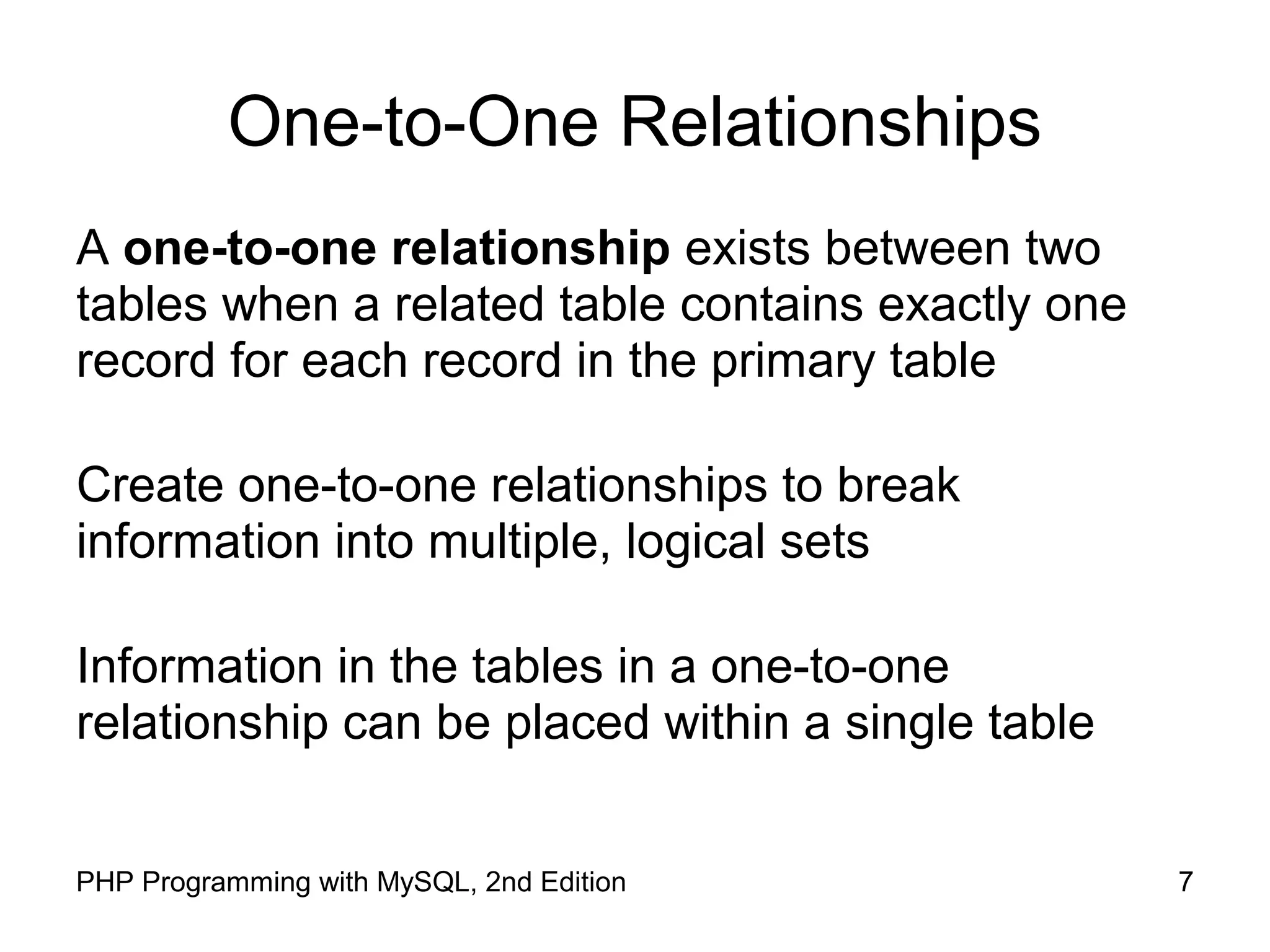
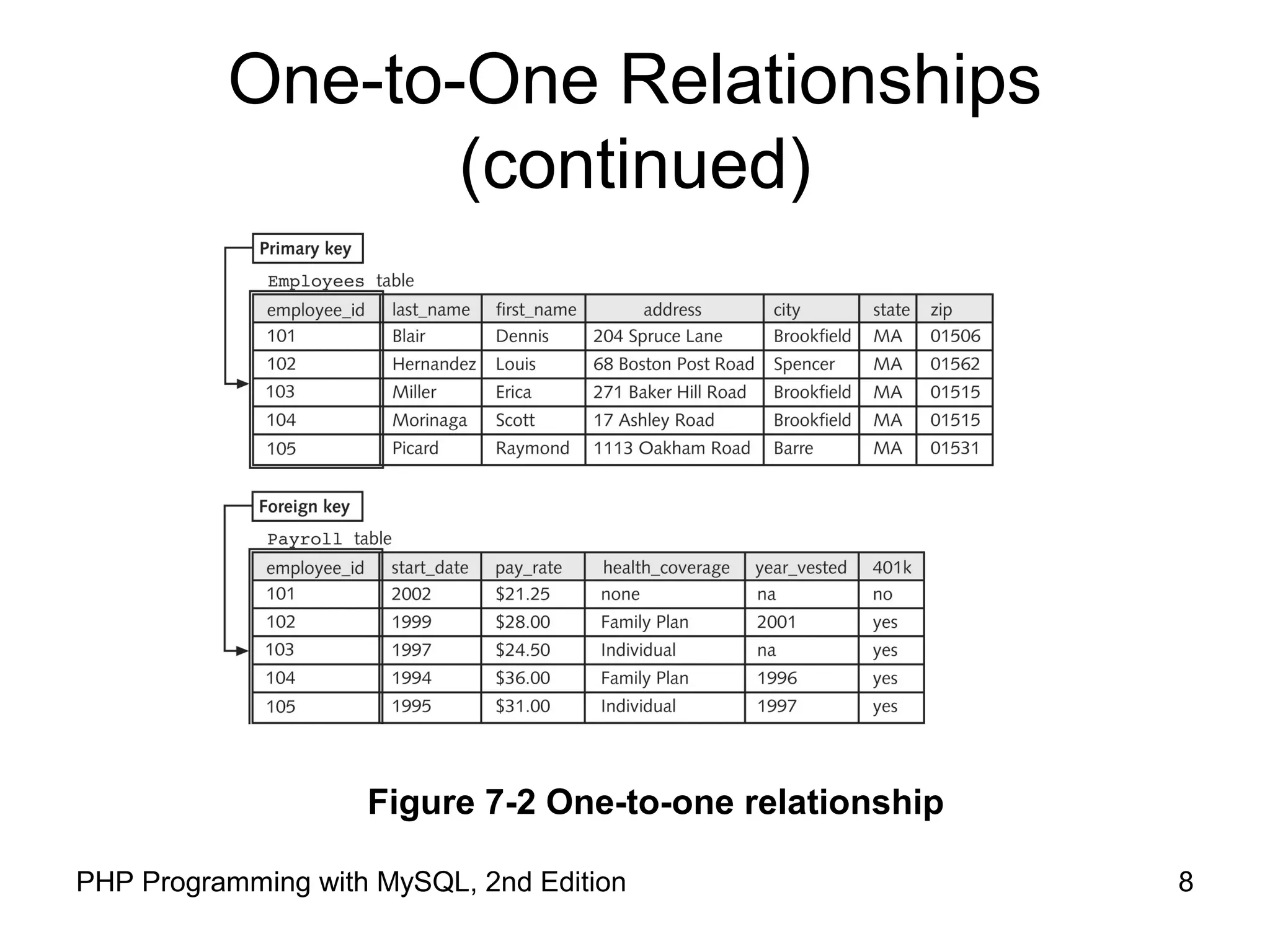
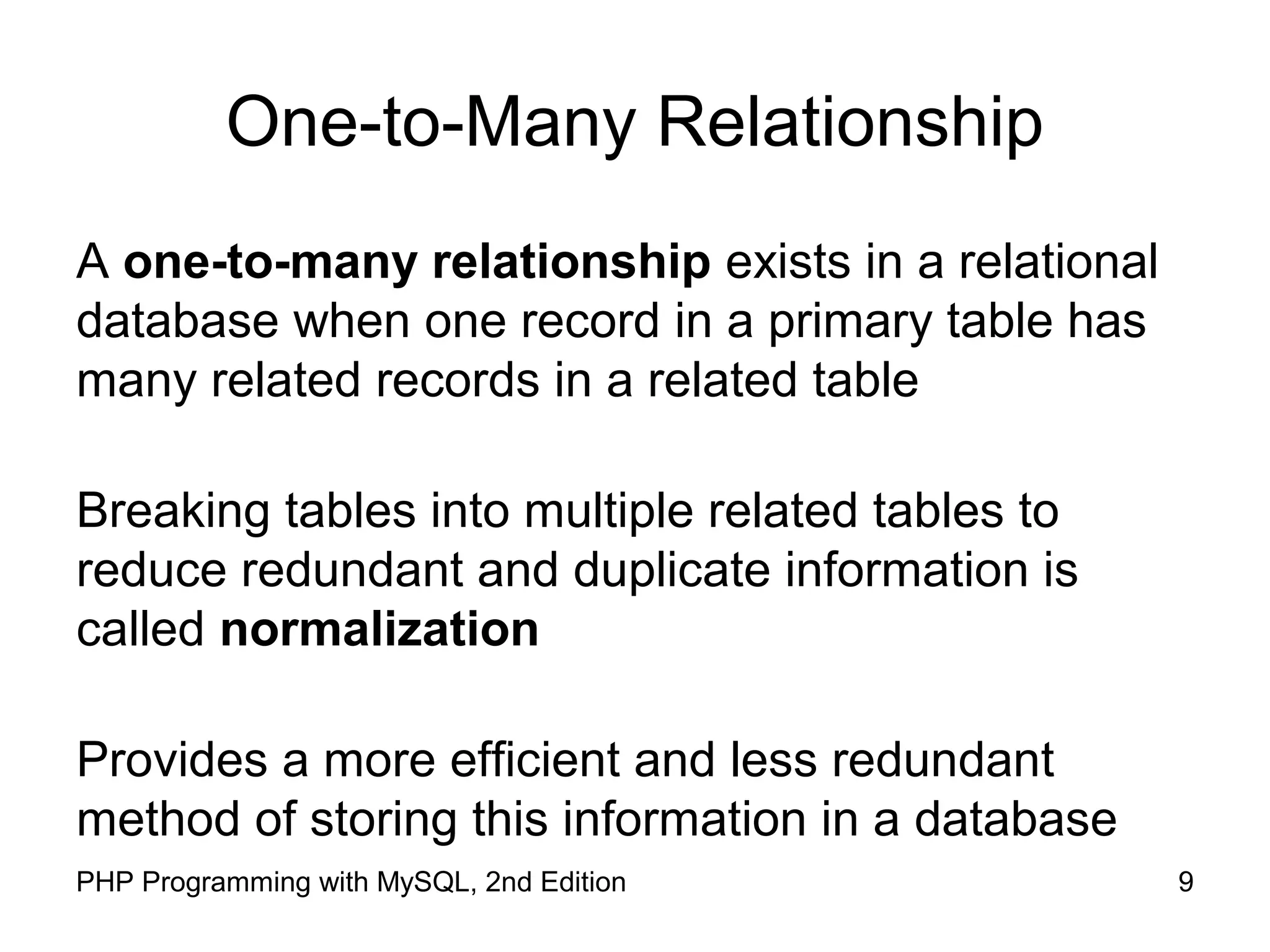
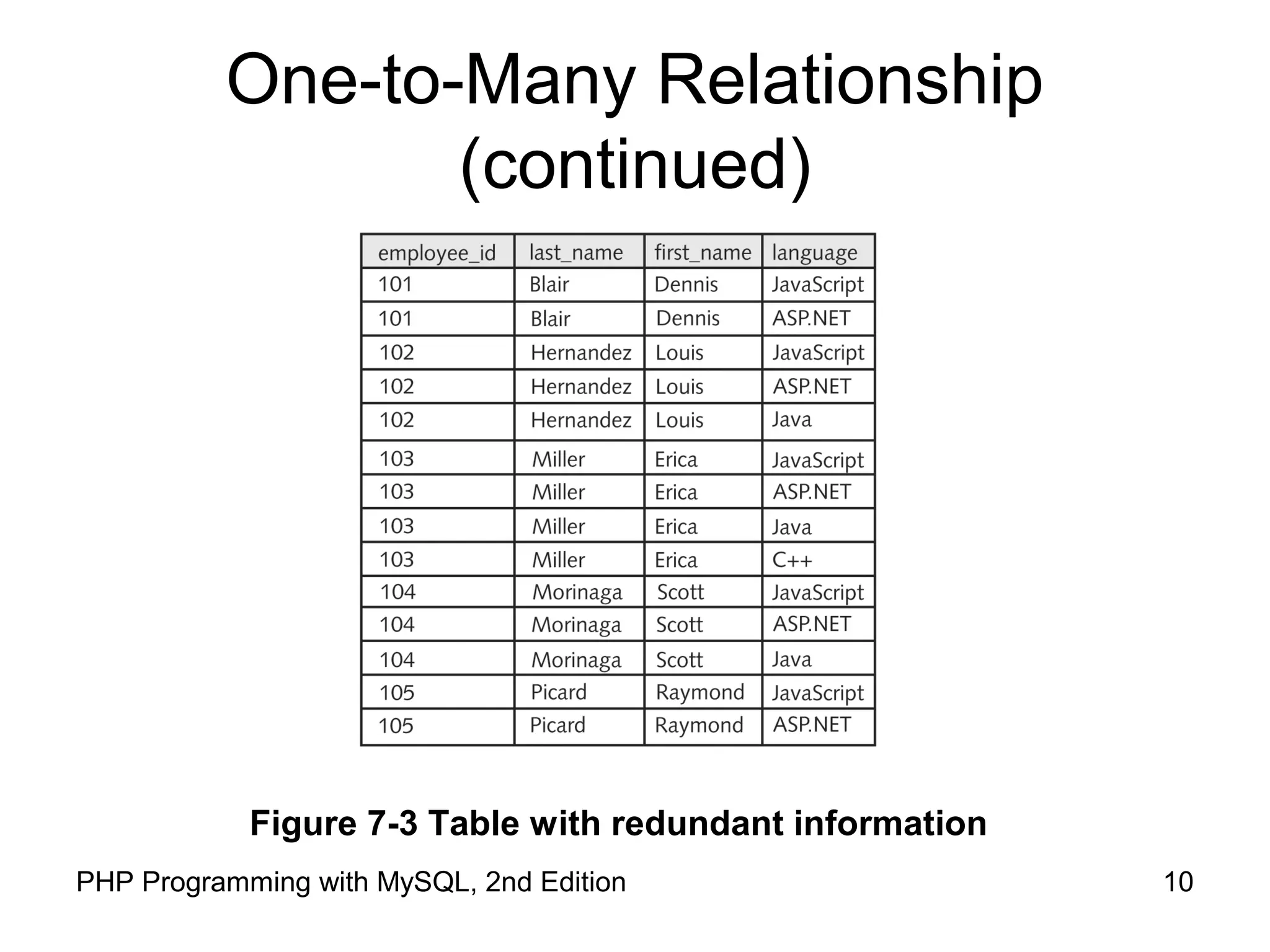
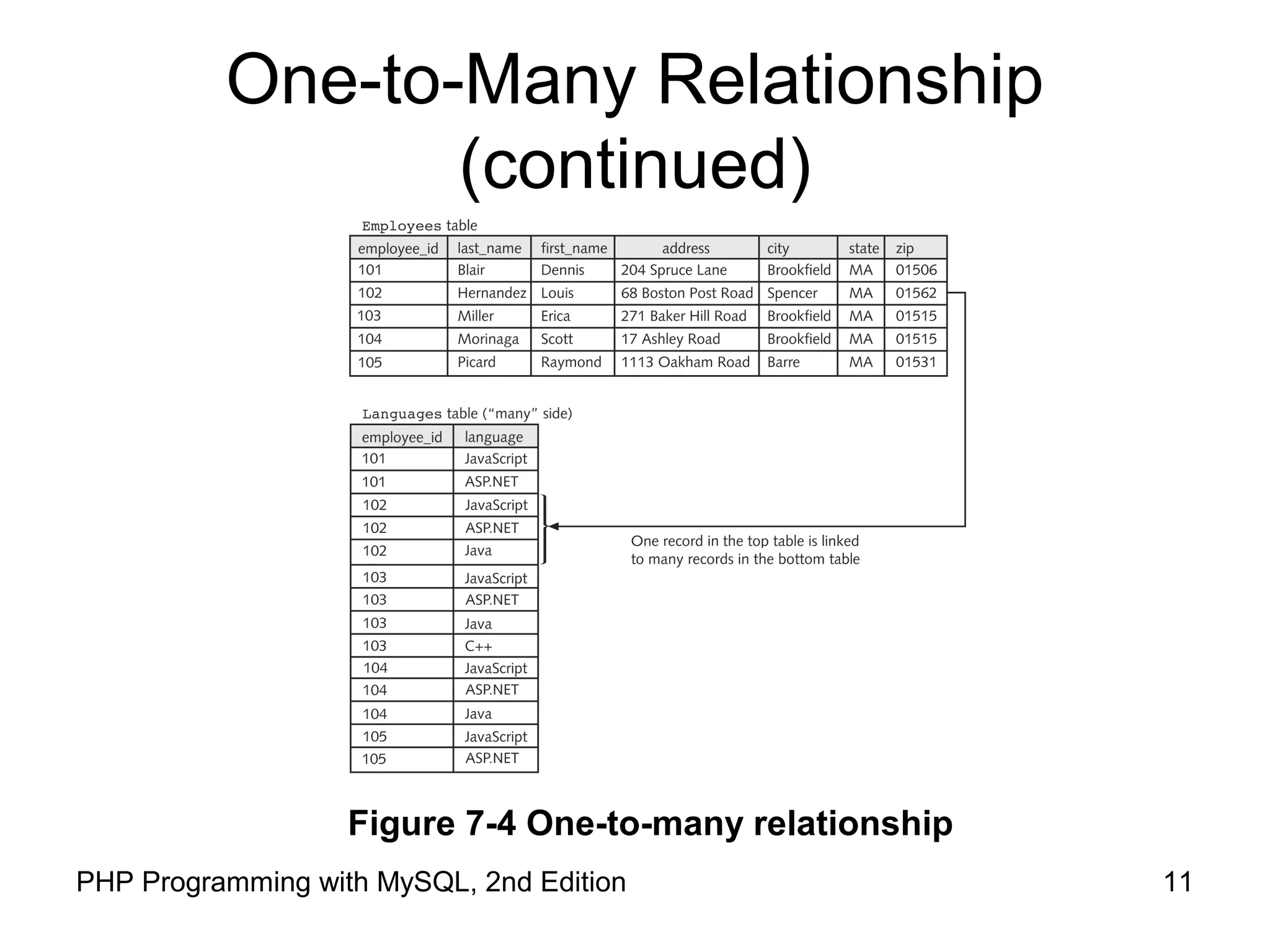
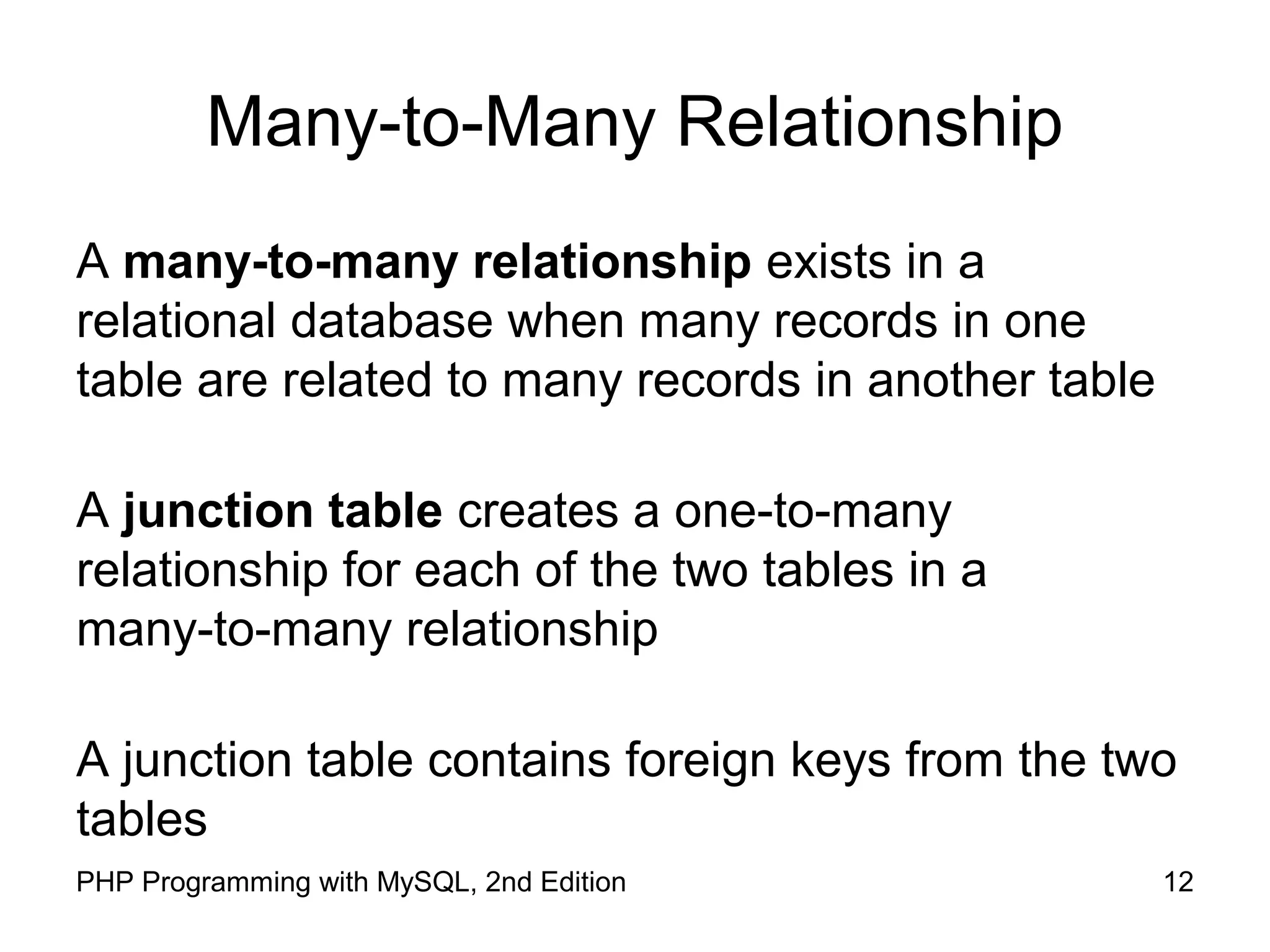
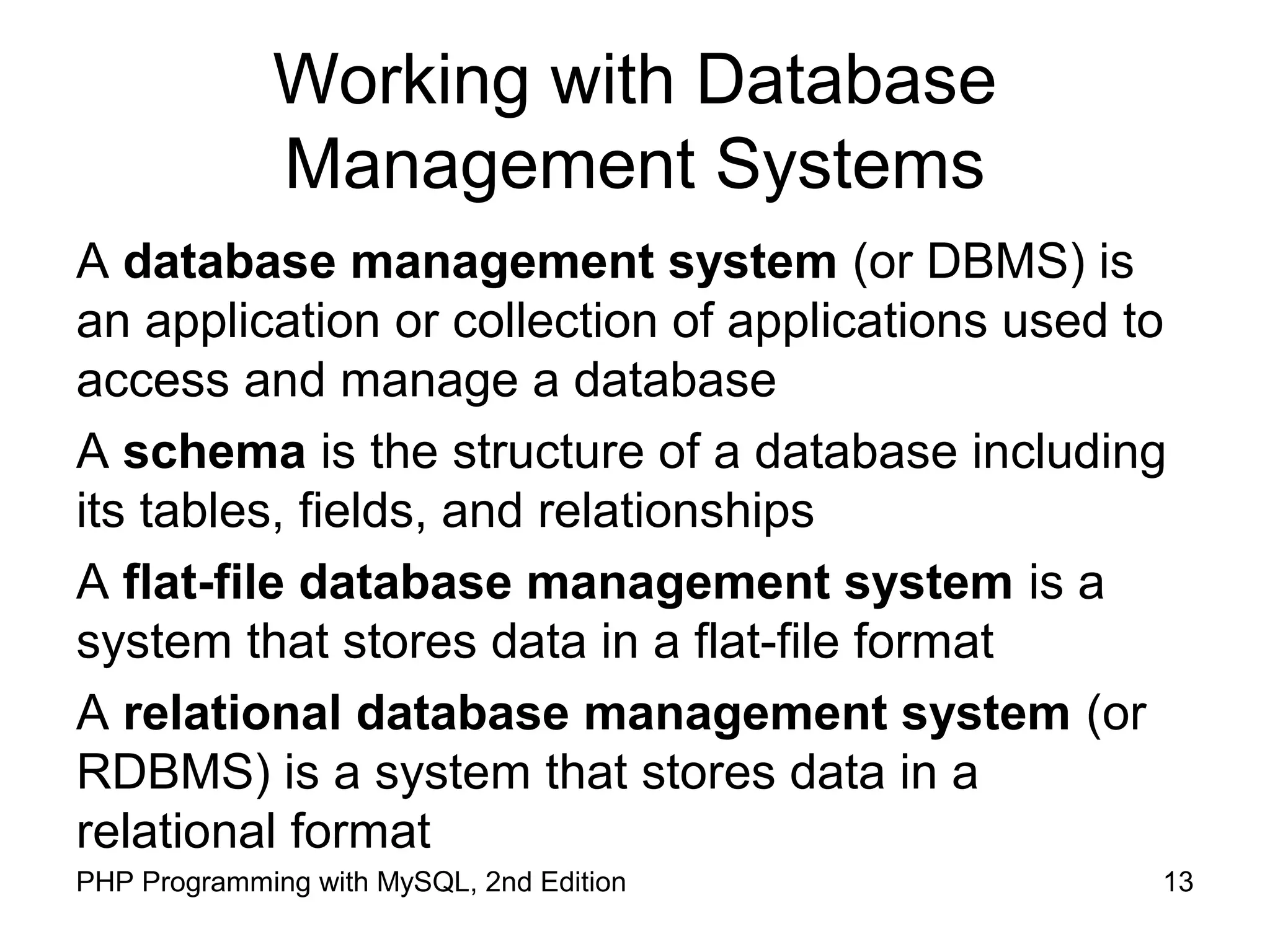
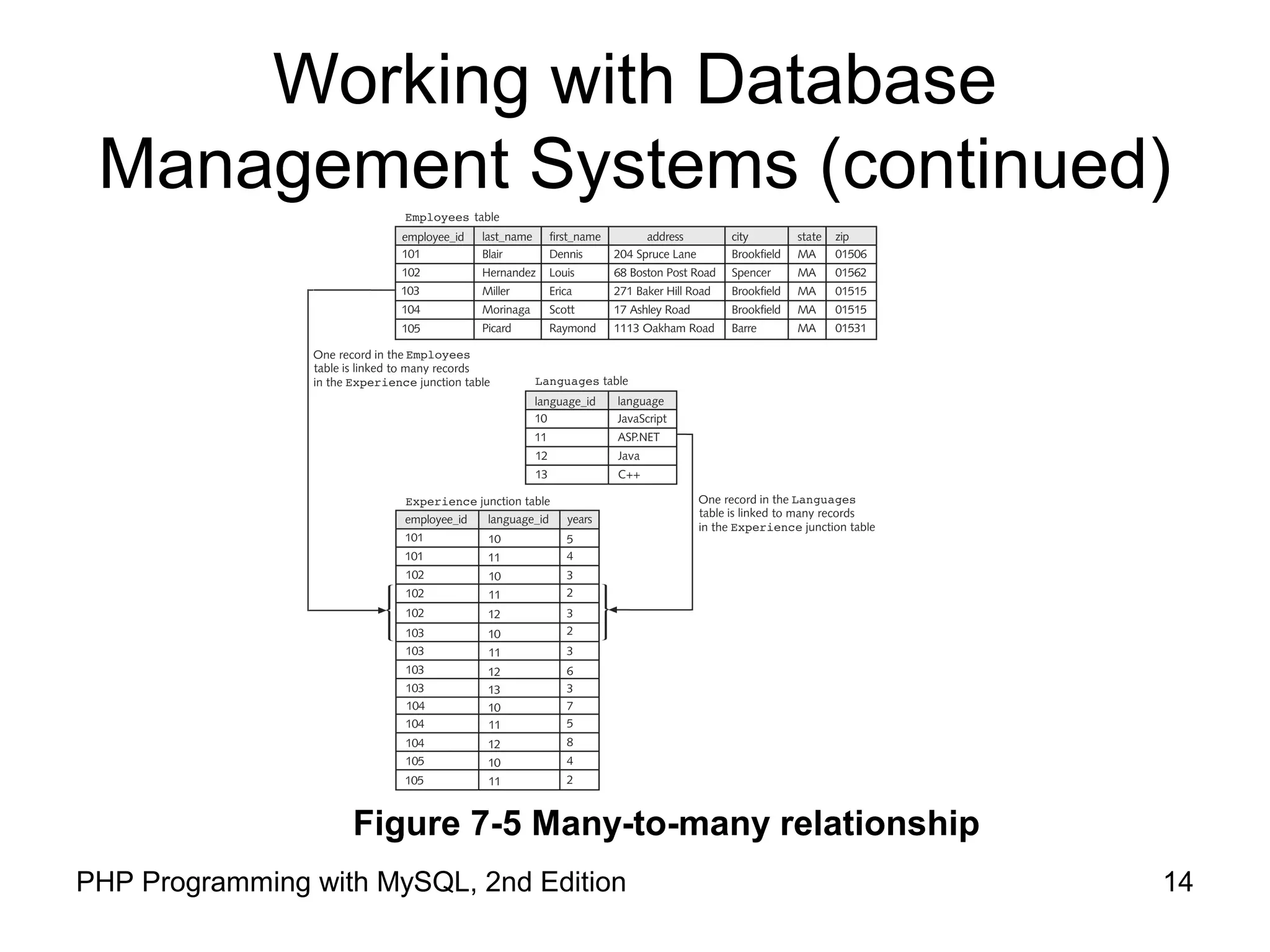
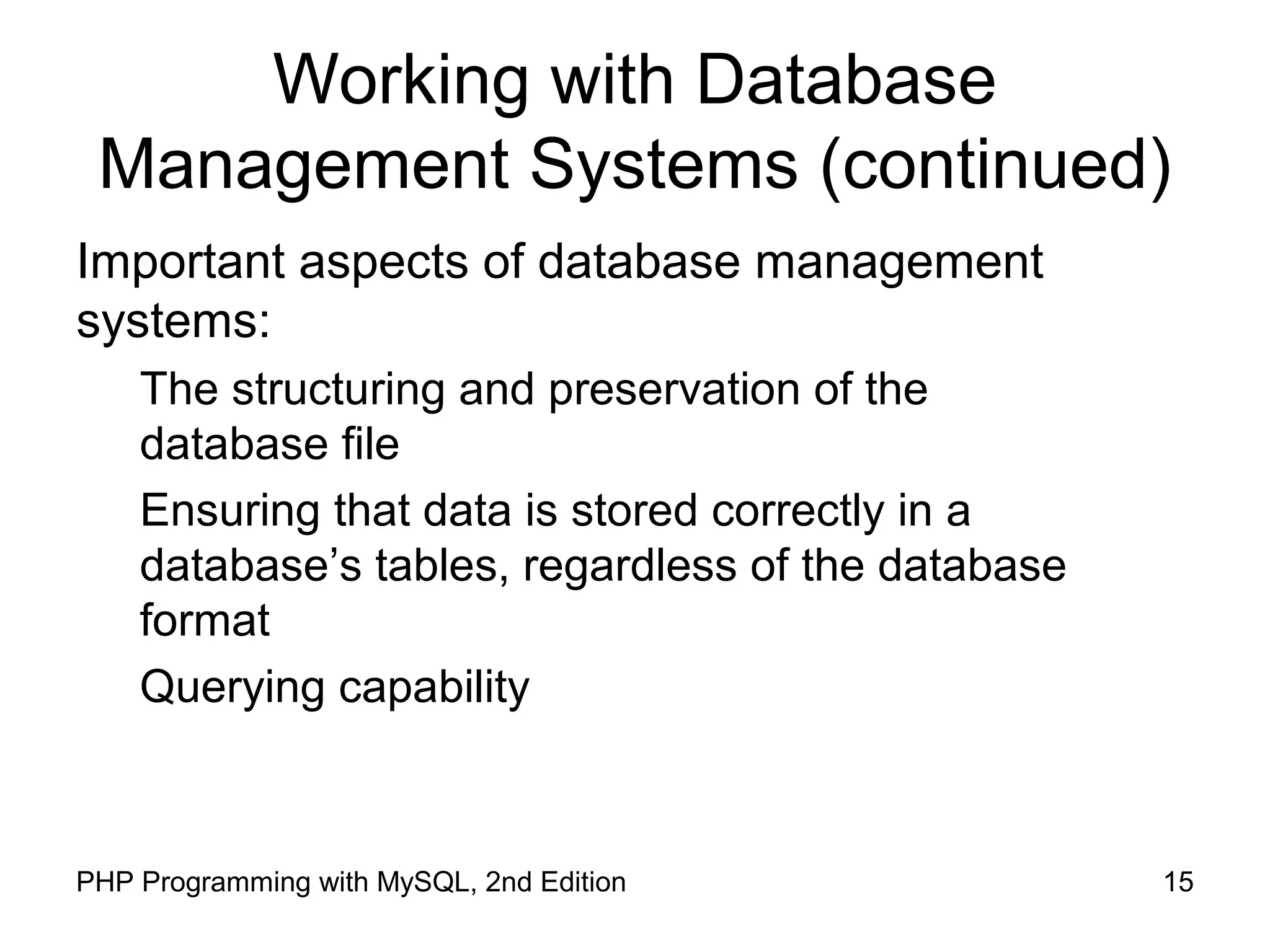
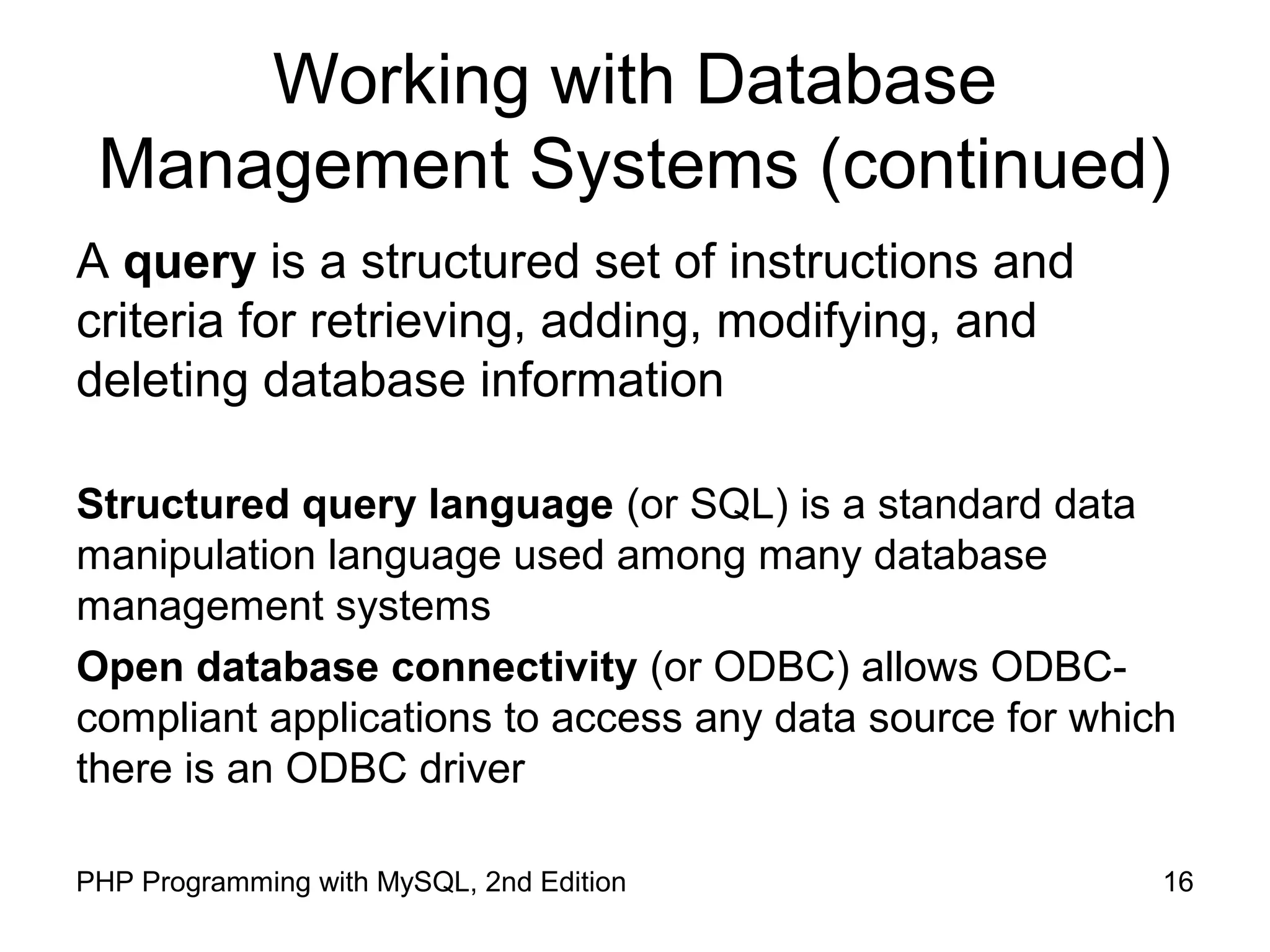
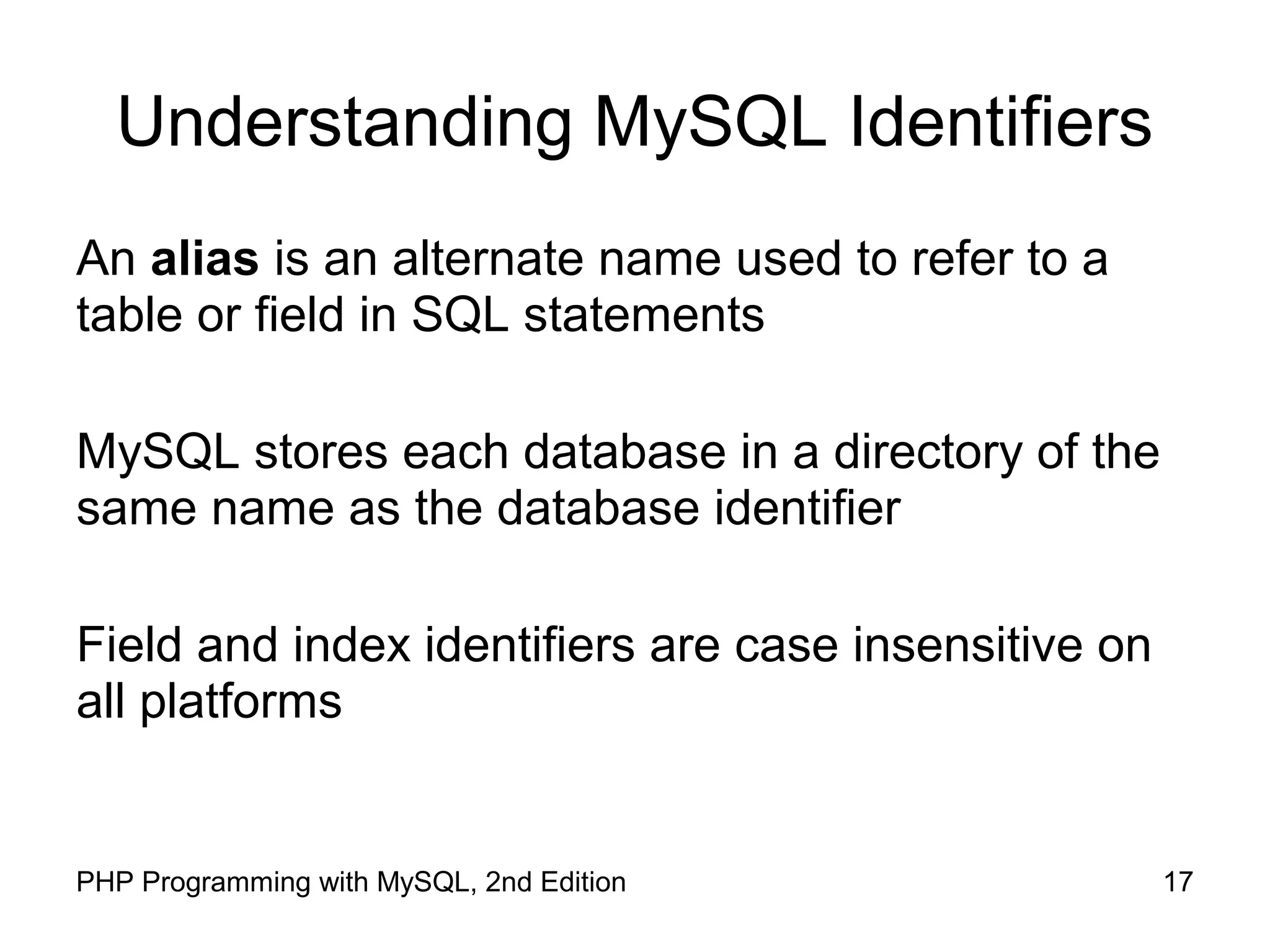
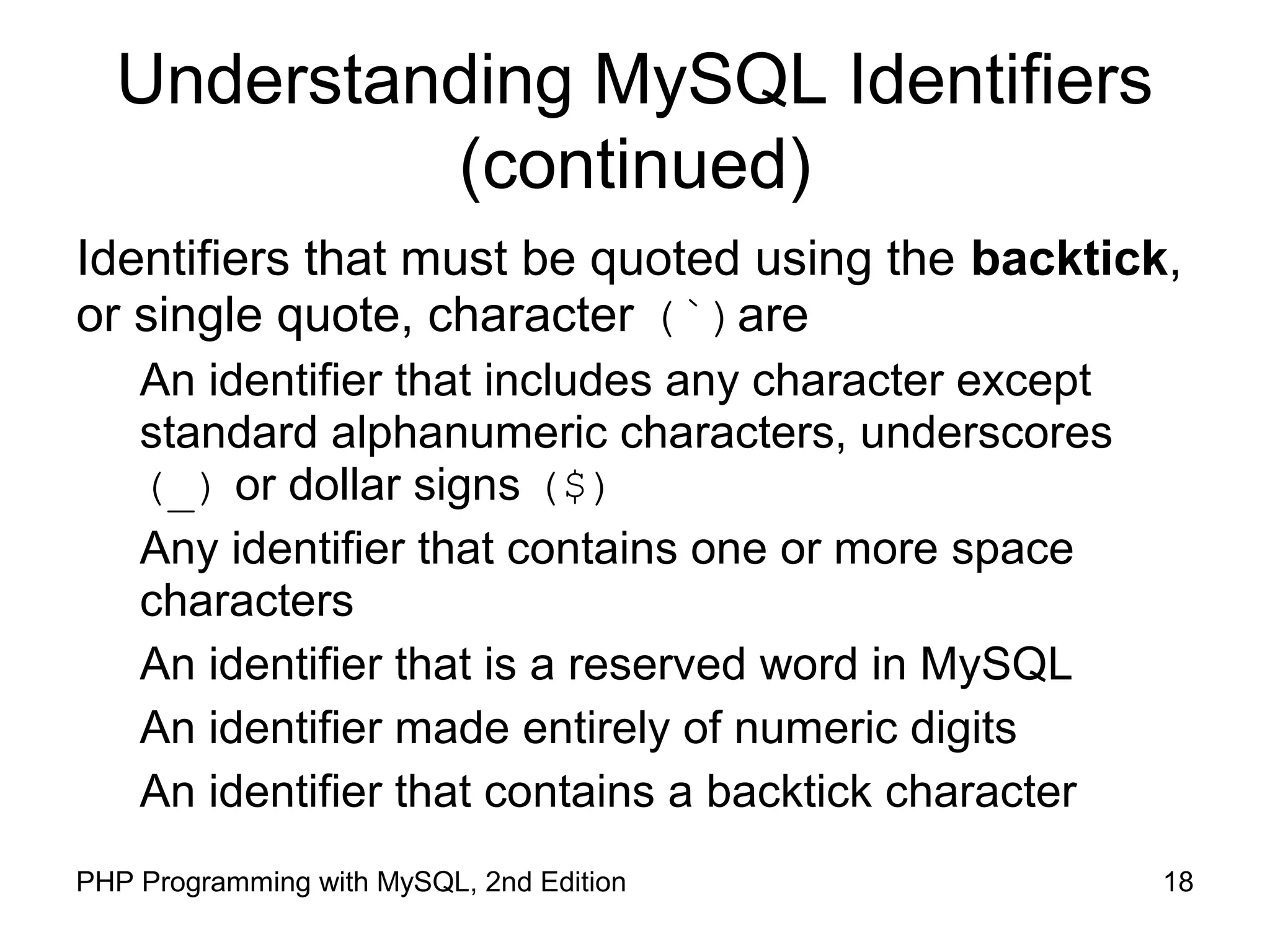
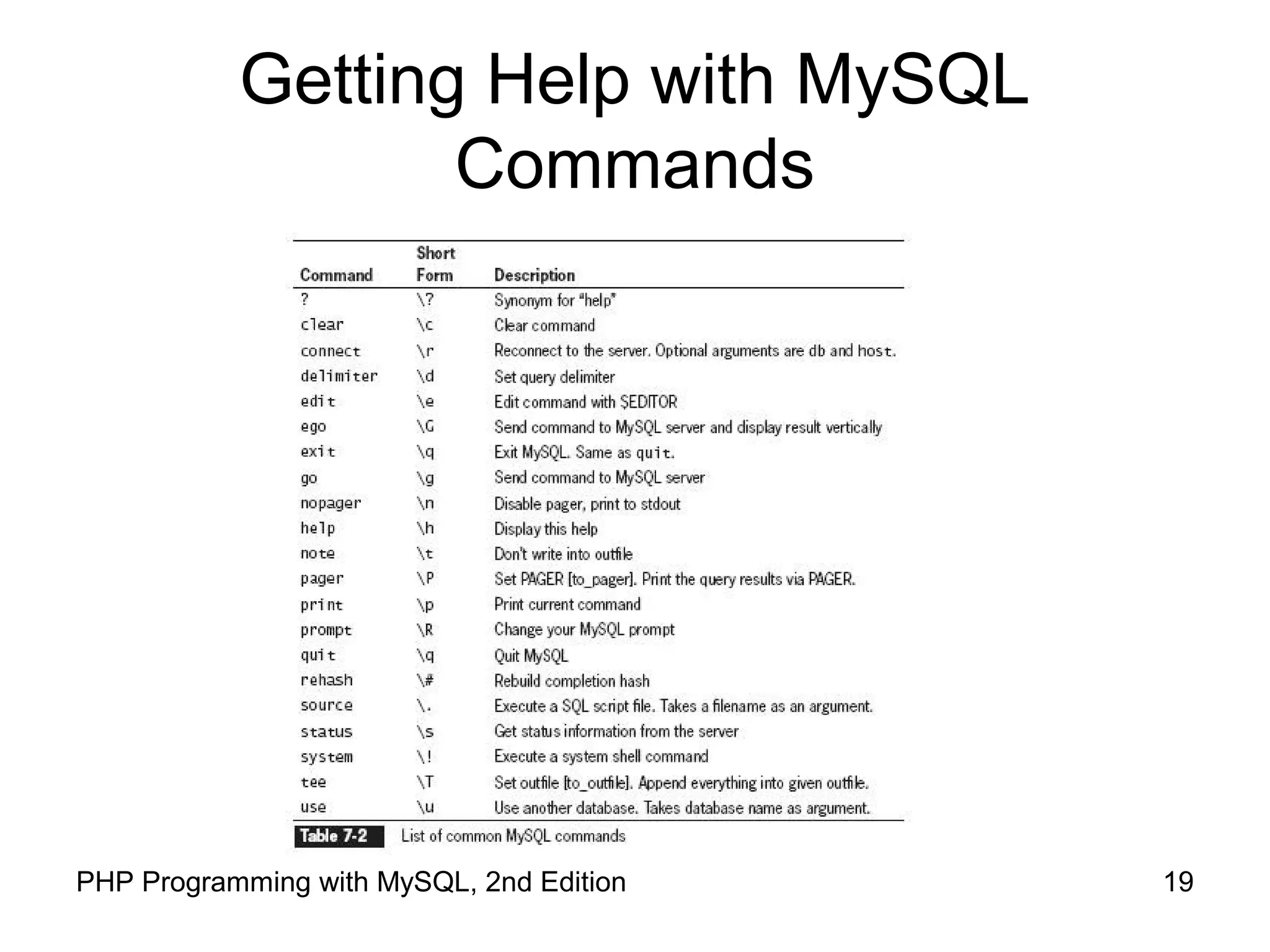
![20PHP Programming with MySQL, 2nd Edition Creating Databases Use the CREATE DATABASE statement to create a new database: mysql> CREATE DATABASE vehicle_fleet;[ENTER] To use a new database, select it by executing the USE DATABASE statement](https://image.slidesharecdn.com/workingwithdatabasesandmysql-150317100342-conversion-gate01/75/Working-with-Databases-and-MySQL-20-2048.jpg)
![21PHP Programming with MySQL, 2nd Edition Selecting a Database Use the DATABASE() function to return the name of the currently active database mysql> SELECT DATABASE();[ENTER] View the available databases using the SHOW DATABASES statement mysql> SHOW databases;[ENTER] Use the DROP DATABASE statement to remove all tables and delete a database mysql> DROP DATABASE database;](https://image.slidesharecdn.com/workingwithdatabasesandmysql-150317100342-conversion-gate01/75/Working-with-Databases-and-MySQL-21-2048.jpg)
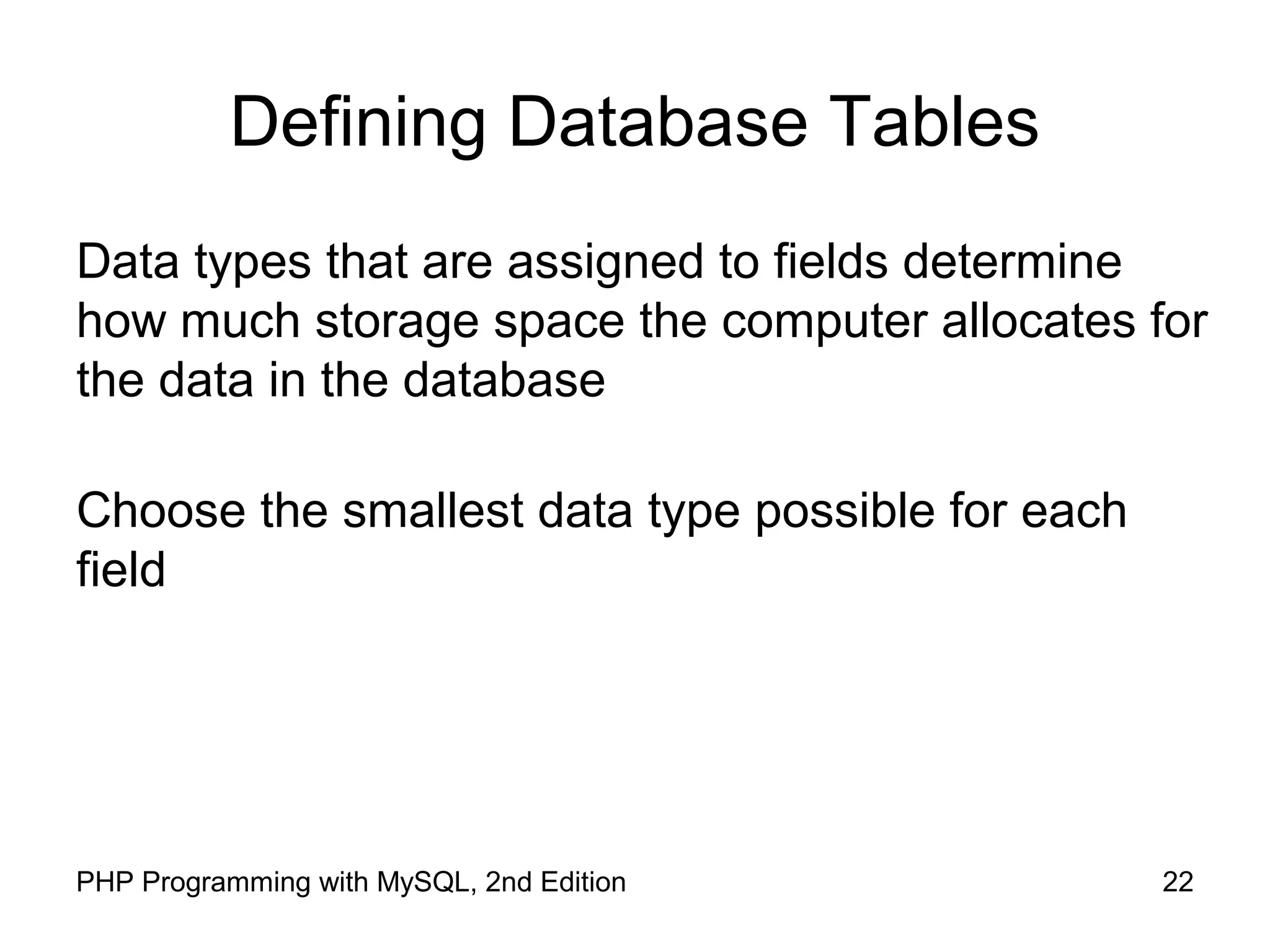
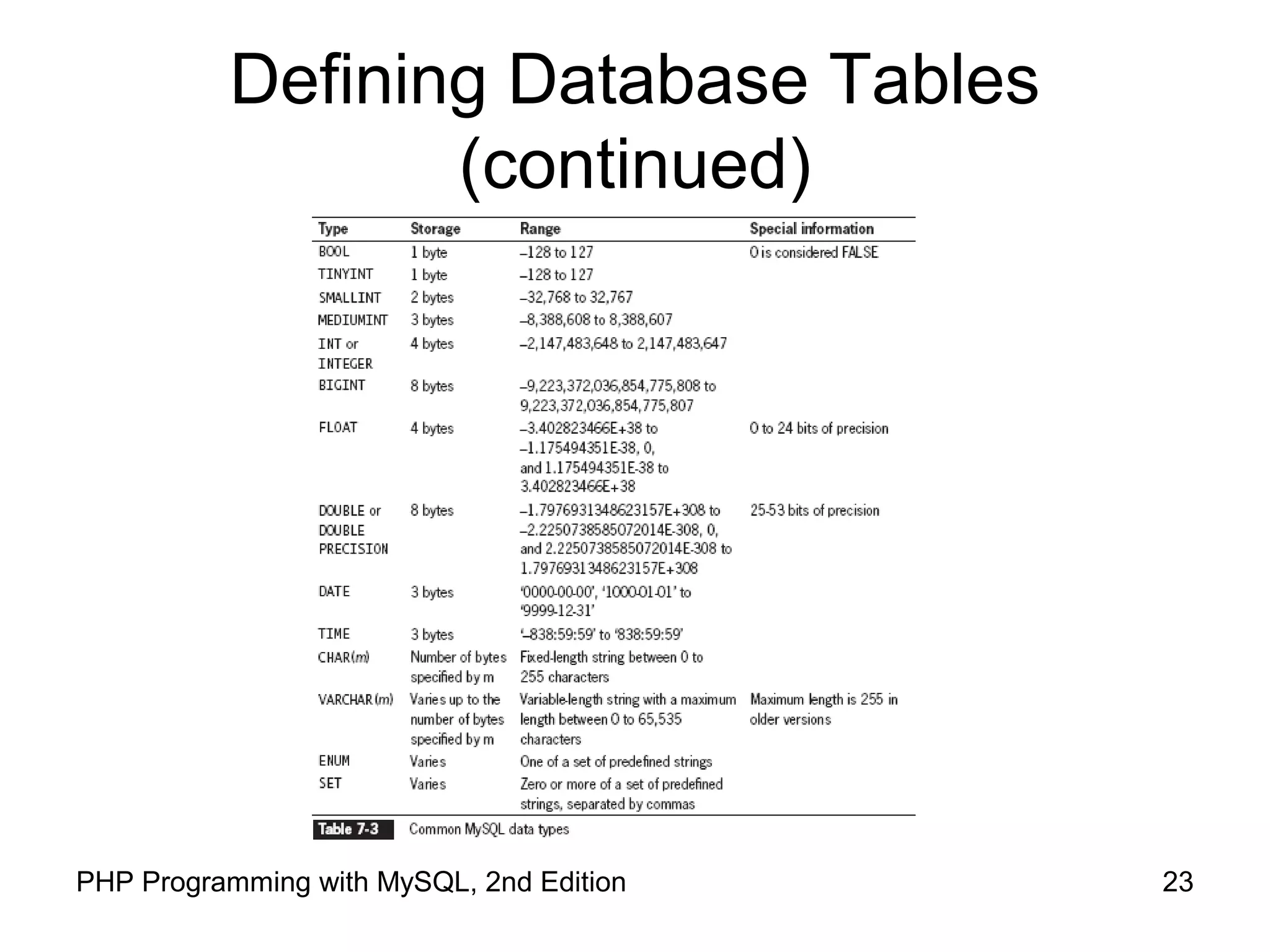
![Creating Tables Use the CREATE TABLE statement to create a new table and define the column names and data types for each column mysql> CREATE TABLE vehicles (license VARCHAR(10), make VARCHAR(25), model VARCHAR(50), miles FLOAT, assigned_to VARCHAR(40));[ENTER] 24PHP Programming with MySQL, 2nd Edition](https://image.slidesharecdn.com/workingwithdatabasesandmysql-150317100342-conversion-gate01/75/Working-with-Databases-and-MySQL-24-2048.jpg)
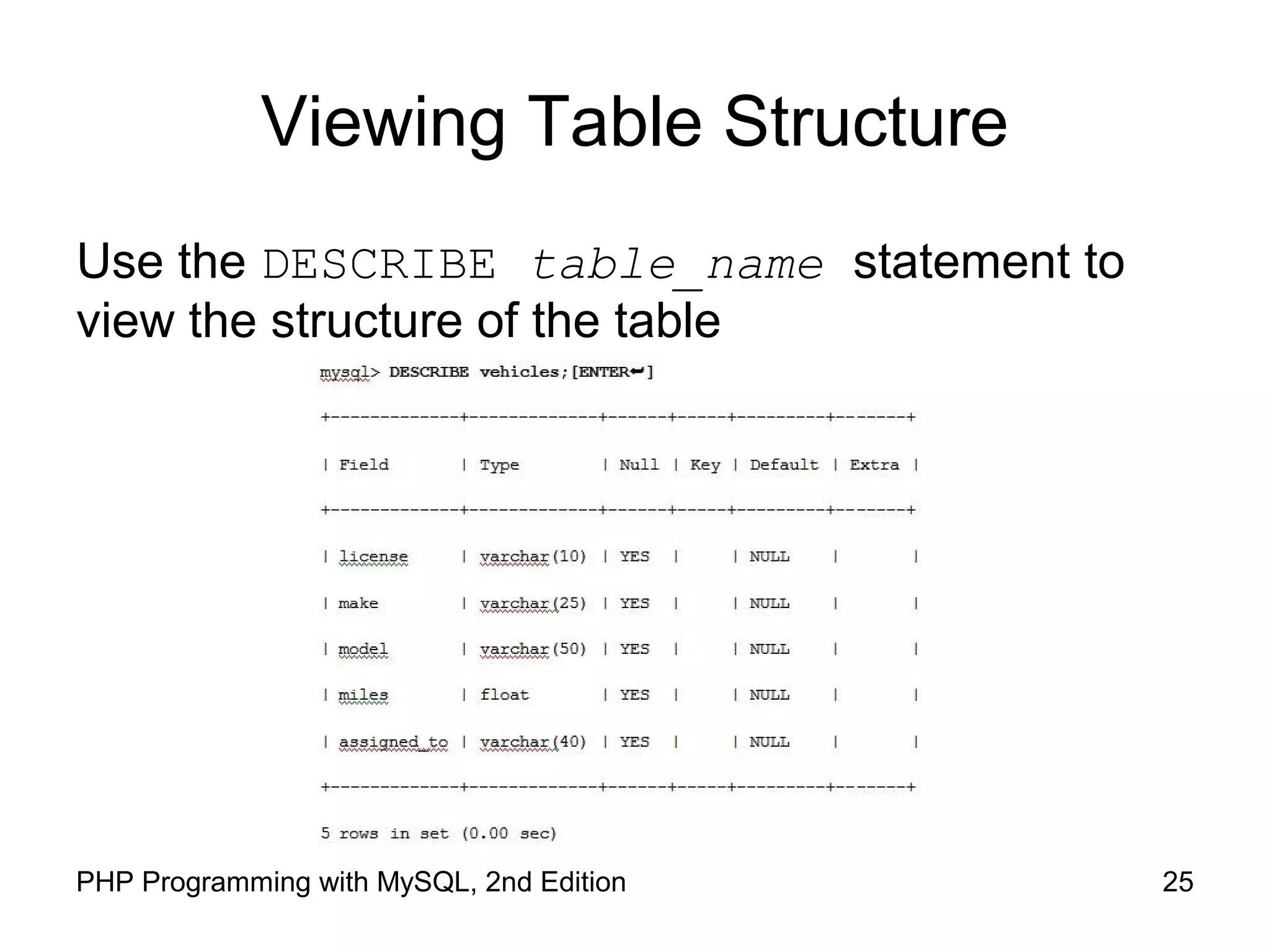
![Changing Table Field Names Use the ALTER TABLE to change the name of an existing field in a table using the following syntax ALTER TABLE table_name ADD [COLUMN] (column_name column_type [, column_name column_type ...]); In MySQL Monitor, enter the following: mysql> ALTER TABLE vehicles ADD COLUMN (model_year INT);[ENTER] 26PHP Programming with MySQL, 2nd Edition](https://image.slidesharecdn.com/workingwithdatabasesandmysql-150317100342-conversion-gate01/75/Working-with-Databases-and-MySQL-26-2048.jpg)
![Modifying Column Types Use the ALTER TABLE to rename columns of an existing field in a table using the following syntax ALTER TABLE table_name CHANGE [COLUMN] column_name new_name column_type; In MySQL Monitor, enter the following: mysql> ALTER TABLE vehicles CHANGE COLUMN miles mileage FLOAT;[ENTER] 27PHP Programming with MySQL, 2nd Edition](https://image.slidesharecdn.com/workingwithdatabasesandmysql-150317100342-conversion-gate01/75/Working-with-Databases-and-MySQL-27-2048.jpg)
![Renaming Columns Use the ALTER TABLE to rename columns using the following syntax ALTER TABLE table_name MODIFY [COLUMN] column_name column_type; In MySQL Monitor, enter the following: mysql> ALTER TABLE vehicles MODIFY COLUMN model_year SMALLINT;[ENTER] 28PHP Programming with MySQL, 2nd Edition](https://image.slidesharecdn.com/workingwithdatabasesandmysql-150317100342-conversion-gate01/75/Working-with-Databases-and-MySQL-28-2048.jpg)
![Renaming Tables Use the ALTER TABLE to change the name of an existing table using the following syntax ALTER TABLE table_name RENAME [TO] new_name; mysql> ALTER TABLE vehicles RENAME TO company_cars;[ENTER] 29PHP Programming with MySQL, 2nd Edition](https://image.slidesharecdn.com/workingwithdatabasesandmysql-150317100342-conversion-gate01/75/Working-with-Databases-and-MySQL-29-2048.jpg)
![Removing Columns Use the ALTER TABLE to remove an existing field from a table using the following syntax ALTER TABLE table_name DROP [COLUMN] column_name; mysql> ALTER TABLE company_cars DROP COLUMN assigned_to;[ENTER] 30PHP Programming with MySQL, 2nd Edition](https://image.slidesharecdn.com/workingwithdatabasesandmysql-150317100342-conversion-gate01/75/Working-with-Databases-and-MySQL-30-2048.jpg)
![Deleting Tables Execute the DROP TABLE statement to remove all data and the table definition from a database DROP TABLE table; In MySQL Monitor, enter the following at the mysql> prompt: mysql> DROP TABLE company_cars;[ENTER] You must be logged in as the root user or have DROP privileges to delete a table. 31PHP Programming with MySQL, 2nd Edition](https://image.slidesharecdn.com/workingwithdatabasesandmysql-150317100342-conversion-gate01/75/Working-with-Databases-and-MySQL-31-2048.jpg)
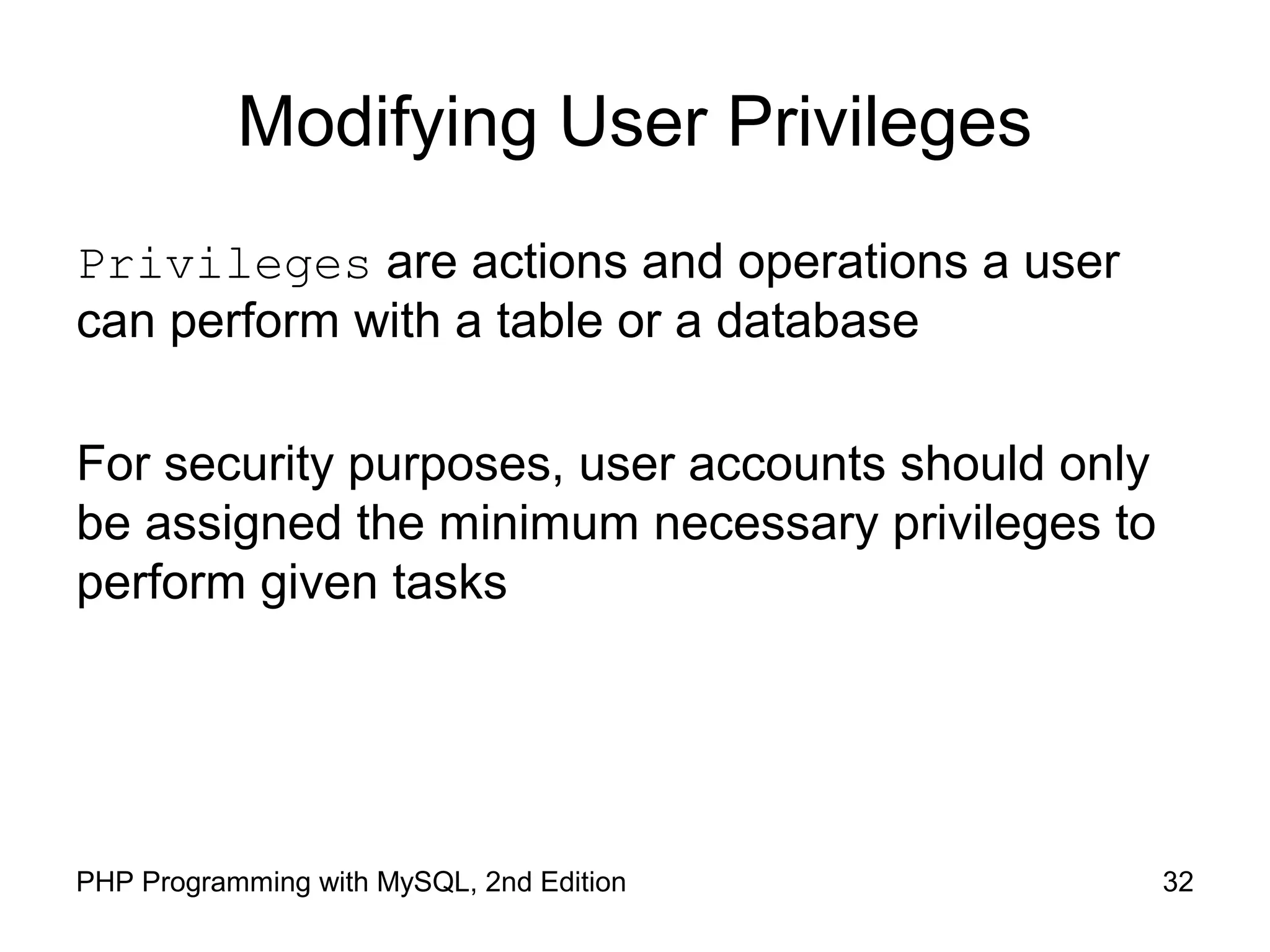
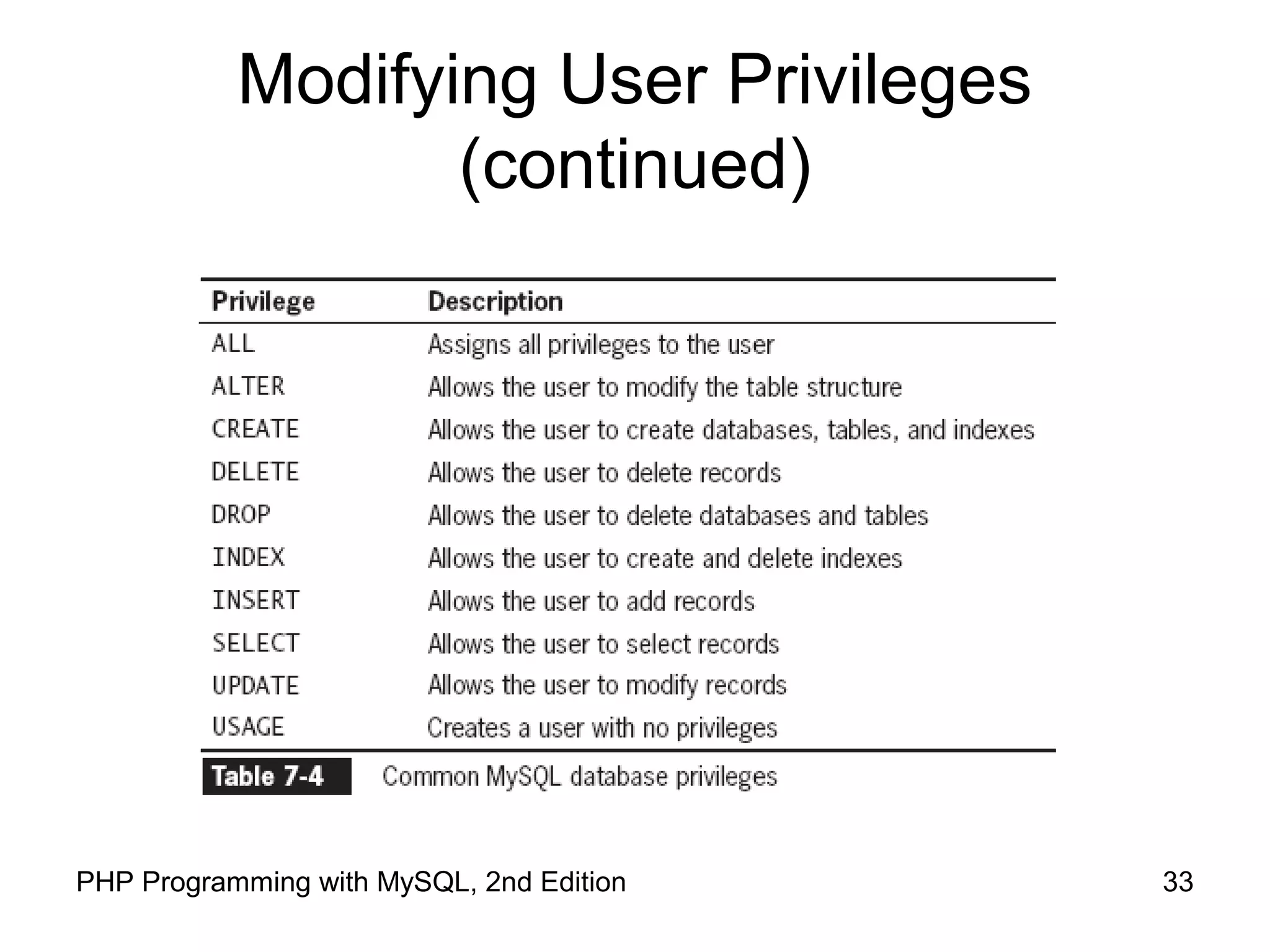
![34PHP Programming with MySQL, 2nd Edition Granting Privileges The syntax for the GRANT statement is: GRANT privilege [(column)] [, privilege [(columns)]] ... ON {table | * | *.* | database.*} TO user [IDENTIFIED BY 'password']; The GRANT statement creates the user account if it does not exist and assigns the specified privileges If the user account already exists, the GRANT statement just updates the privileges](https://image.slidesharecdn.com/workingwithdatabasesandmysql-150317100342-conversion-gate01/75/Working-with-Databases-and-MySQL-34-2048.jpg)
![35PHP Programming with MySQL, 2nd Edition Revoking Privileges The syntax for the REVOKE statement is: REVOKE privilege [(column)] [, privilege [(columns)]] ... ON {table | * | *.* | database.*} FROM user; The REVOKE ALL PRIVILEGES statement removes all privileges from a user account for a specified table or database You must be logged in with the root account or have sufficient privileges to revoke privileges from another user account](https://image.slidesharecdn.com/workingwithdatabasesandmysql-150317100342-conversion-gate01/75/Working-with-Databases-and-MySQL-35-2048.jpg)
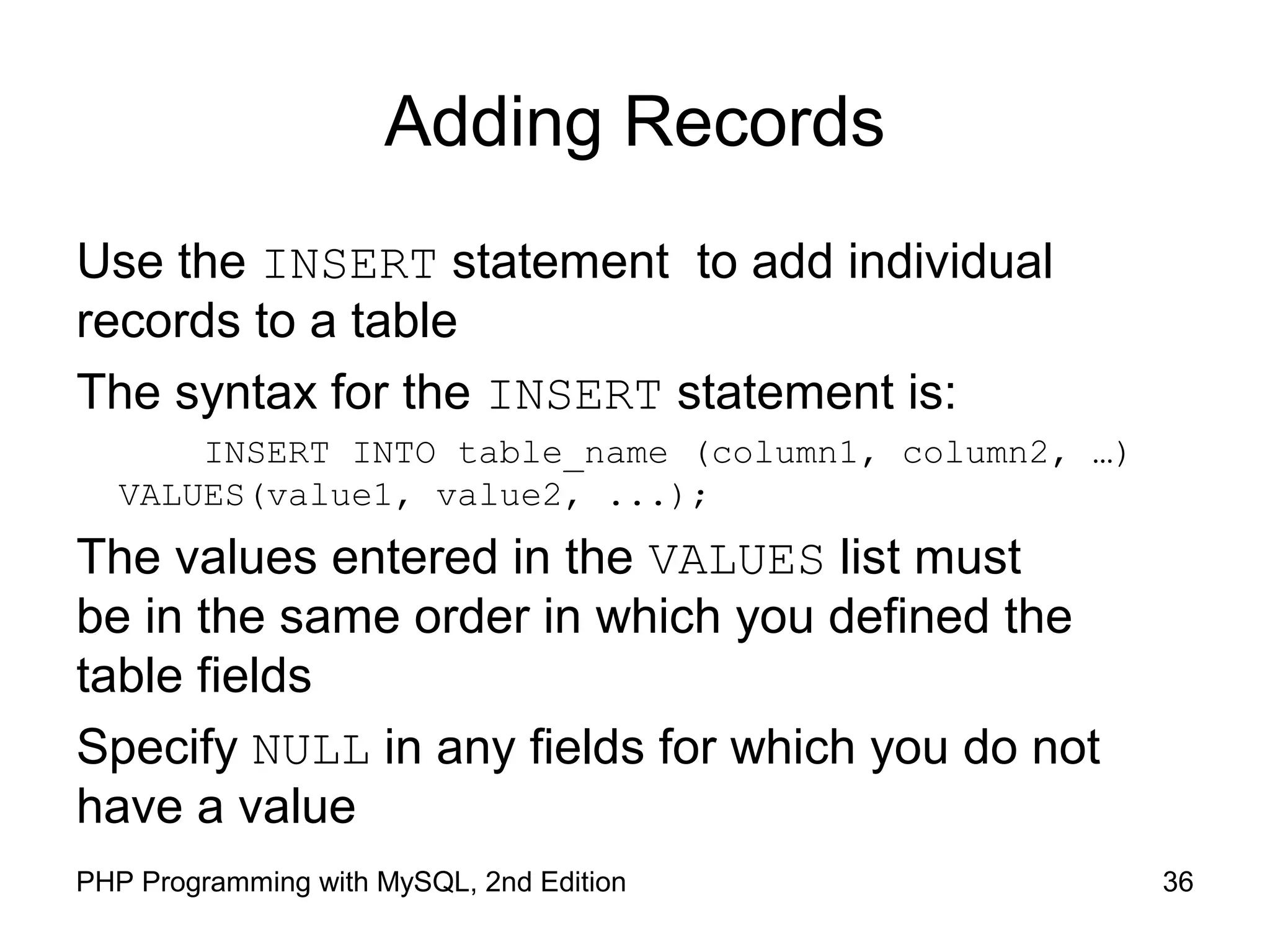
![37PHP Programming with MySQL, 2nd Edition Adding Records (continued) mysql> INSERT INTO company_cars(license, model_year, make, model, mileage) VALUES('CK-2987', 2009, 'Toyota', 'Corolla', 3508.4);[ENTER]](https://image.slidesharecdn.com/workingwithdatabasesandmysql-150317100342-conversion-gate01/75/Working-with-Databases-and-MySQL-37-2048.jpg)
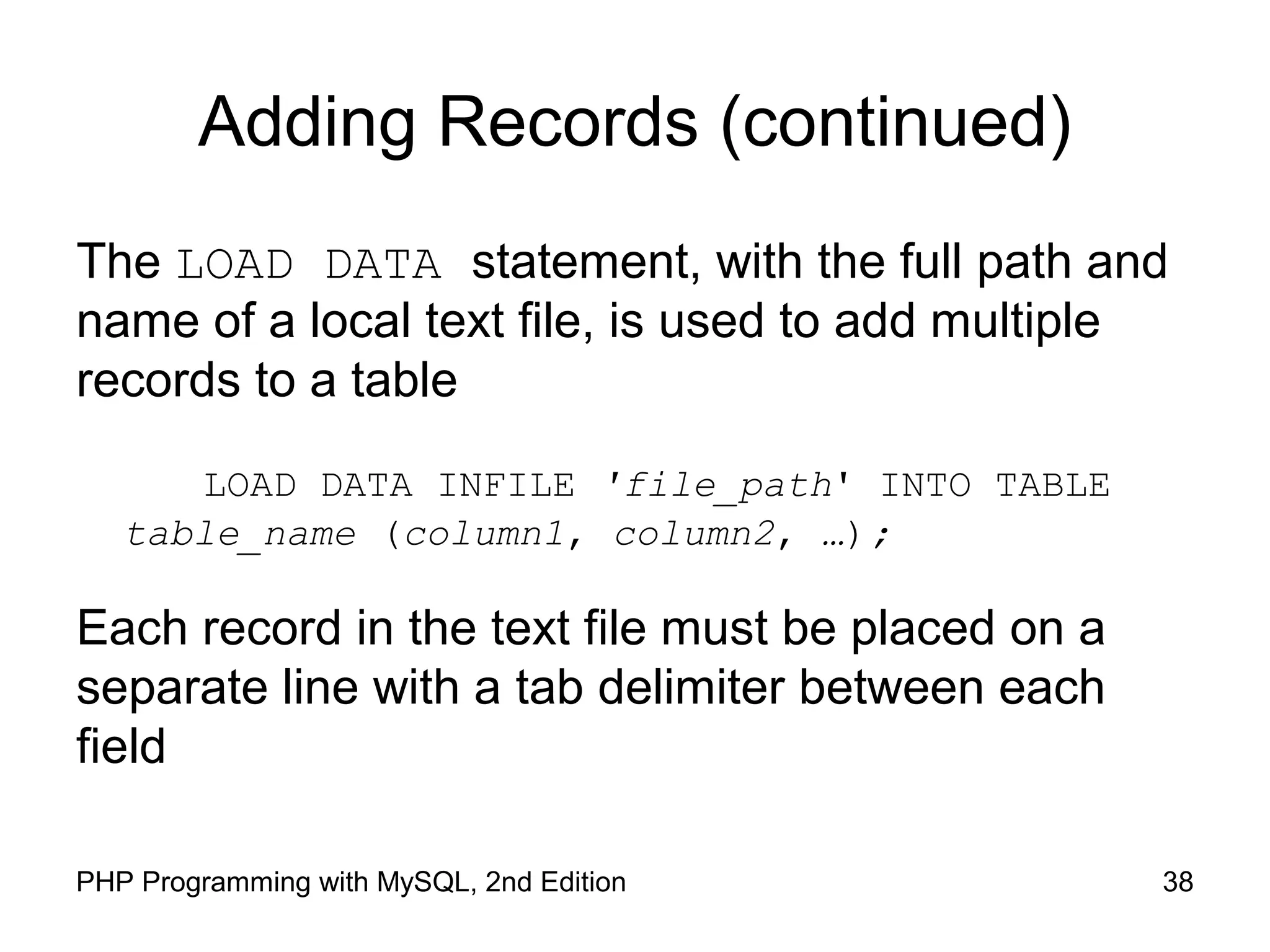
![Adding Records (continued) If the column list is omitted, the values on each line must be in the same order you defined the table fields Use consecutive tabs with nothing between them to designate a column with no value mysql> LOAD DATA INFILE 'company_cars.txt' INTO TABLE company_cars;[ENTER] 39PHP Programming with MySQL, 2nd Edition](https://image.slidesharecdn.com/workingwithdatabasesandmysql-150317100342-conversion-gate01/75/Working-with-Databases-and-MySQL-39-2048.jpg)
![Adding Records (continued) The optional FIELDS TERMINATED BY clause of the LOAD DATA statement allows you to change the field separator to a character such as (~ or ,) instead of the default tab character mysql> LOAD DATA INFILE 'company_cars.txt‘ INTO TABLE company_cars;[ENTER] 40PHP Programming with MySQL, 2nd Edition](https://image.slidesharecdn.com/workingwithdatabasesandmysql-150317100342-conversion-gate01/75/Working-with-Databases-and-MySQL-40-2048.jpg)
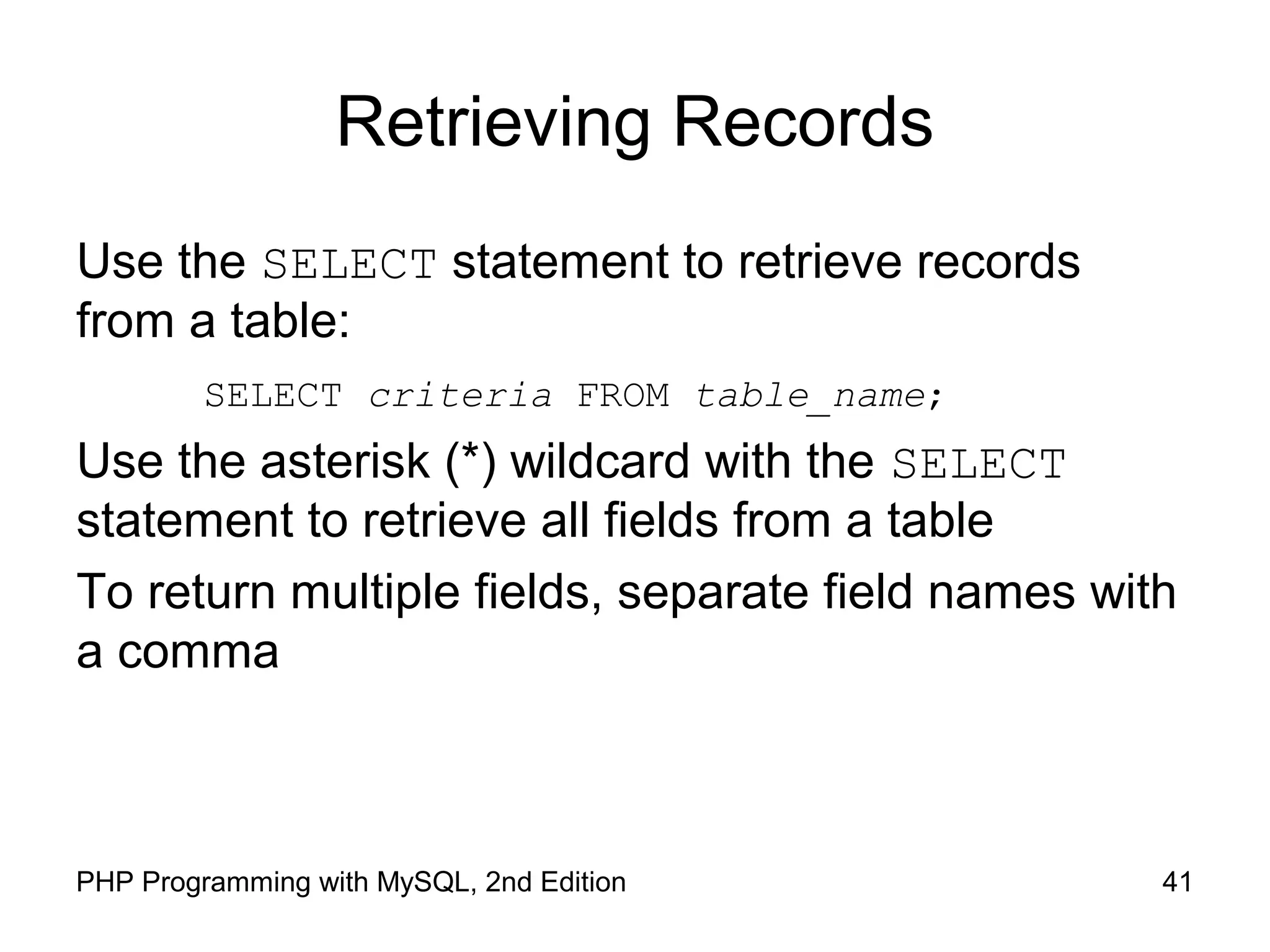
![42PHP Programming with MySQL, 2nd Edition Retrieving Records (continued) mysql> SELECT model, mileage FROM company_cars;[ENTER]](https://image.slidesharecdn.com/workingwithdatabasesandmysql-150317100342-conversion-gate01/75/Working-with-Databases-and-MySQL-42-2048.jpg)
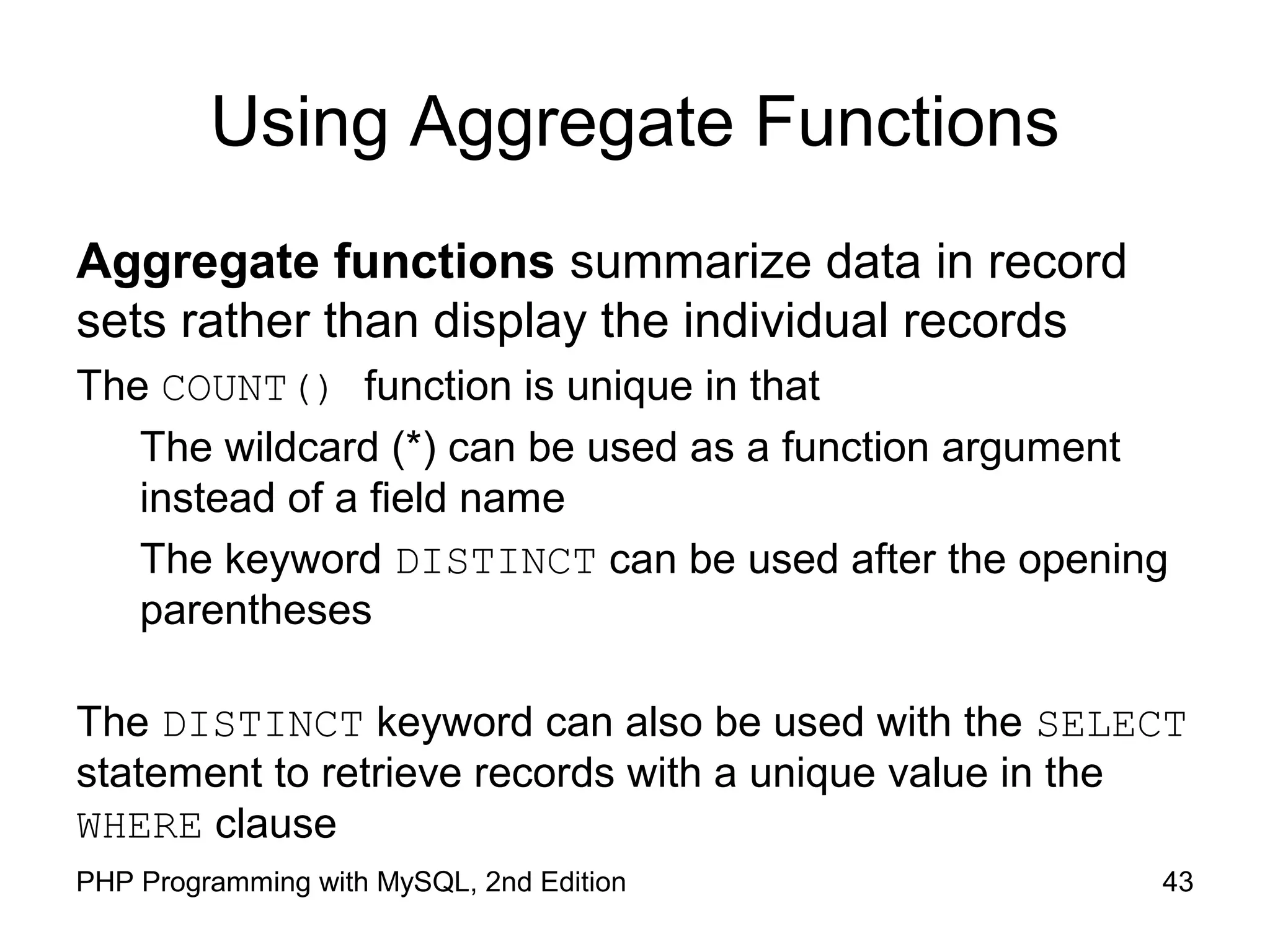
![Using Aggregate Functions (continued) To retrieve aggregate values for groups of records, use the GROUP BY clause and include the fields that you use to group the records as part of the query mysql> SELECT model_year, AVG(mileage) FROM company_cars GROUP BY model_year;[ENTER] 44PHP Programming with MySQL, 2nd Edition](https://image.slidesharecdn.com/workingwithdatabasesandmysql-150317100342-conversion-gate01/75/Working-with-Databases-and-MySQL-44-2048.jpg)
![45PHP Programming with MySQL, 2nd Edition Sorting Query Results Use the ORDER BY keyword with the SELECT statement to perform an alphanumeric sort of the results returned from a query mysql> SELECT make, model FROM inventory ORDER BY make, model;[ENTER]](https://image.slidesharecdn.com/workingwithdatabasesandmysql-150317100342-conversion-gate01/75/Working-with-Databases-and-MySQL-45-2048.jpg)
![46PHP Programming with MySQL, 2nd Edition Sorting Query Results (continued) To perform a reverse sort, add the DESC keyword after the name of the field by which you want to perform the sort mysql> SELECT make, model FROM company_cars ORDER BY make DESC, model;[ENTER]](https://image.slidesharecdn.com/workingwithdatabasesandmysql-150317100342-conversion-gate01/75/Working-with-Databases-and-MySQL-46-2048.jpg)
![47PHP Programming with MySQL, 2nd Edition Filtering Query Results The criteria portion of the SELECT statement determines which fields to retrieve from a table You can also specify which records to return by using the WHERE keyword mysql> SELECT * FROM inventory WHERE make='Martin‘;[ENTER]](https://image.slidesharecdn.com/workingwithdatabasesandmysql-150317100342-conversion-gate01/75/Working-with-Databases-and-MySQL-47-2048.jpg)
![48PHP Programming with MySQL, 2nd Edition Filtering Query Results (continued) Use the keywords AND and OR to specify more detailed conditions about the records you want to return mysql> SELECT * FROM company_cars WHERE model_year=2007 AND mileage<60000;[ENTER]](https://image.slidesharecdn.com/workingwithdatabasesandmysql-150317100342-conversion-gate01/75/Working-with-Databases-and-MySQL-48-2048.jpg)
![49PHP Programming with MySQL, 2nd Edition Filtering Query Results (continued) mysql> SELECT * FROM company_cars WHERE make='Toyota’ OR make='Honda‘ ORDER BY mileage ;[ENTER]](https://image.slidesharecdn.com/workingwithdatabasesandmysql-150317100342-conversion-gate01/75/Working-with-Databases-and-MySQL-49-2048.jpg)
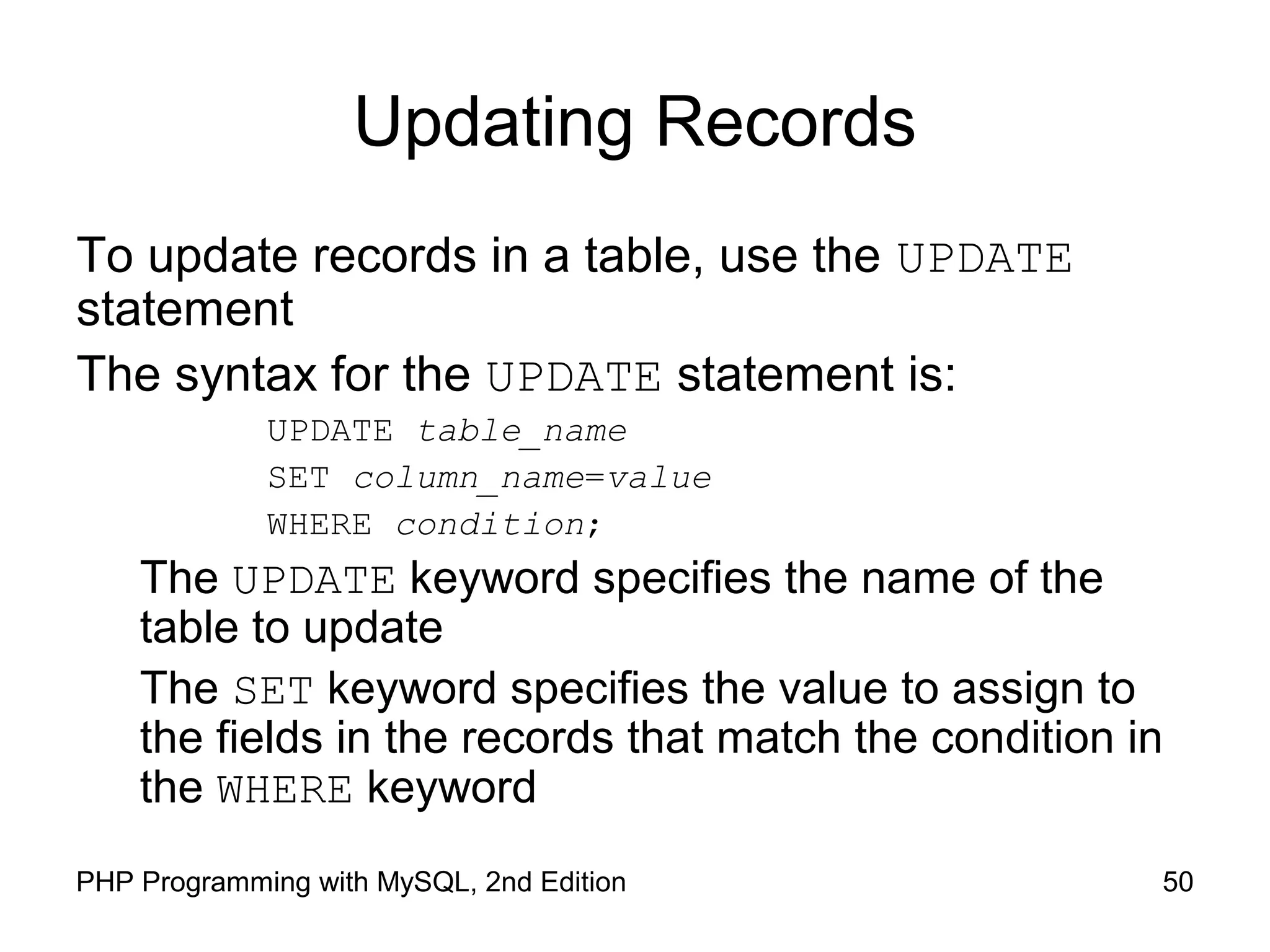
![51PHP Programming with MySQL, 2nd Edition Updating Records (continued) mysql> UPDATE company_cars SET mileage=368.2 WHERE make='Ford’ AND model='Fusion'; [ENTER]](https://image.slidesharecdn.com/workingwithdatabasesandmysql-150317100342-conversion-gate01/75/Working-with-Databases-and-MySQL-51-2048.jpg)
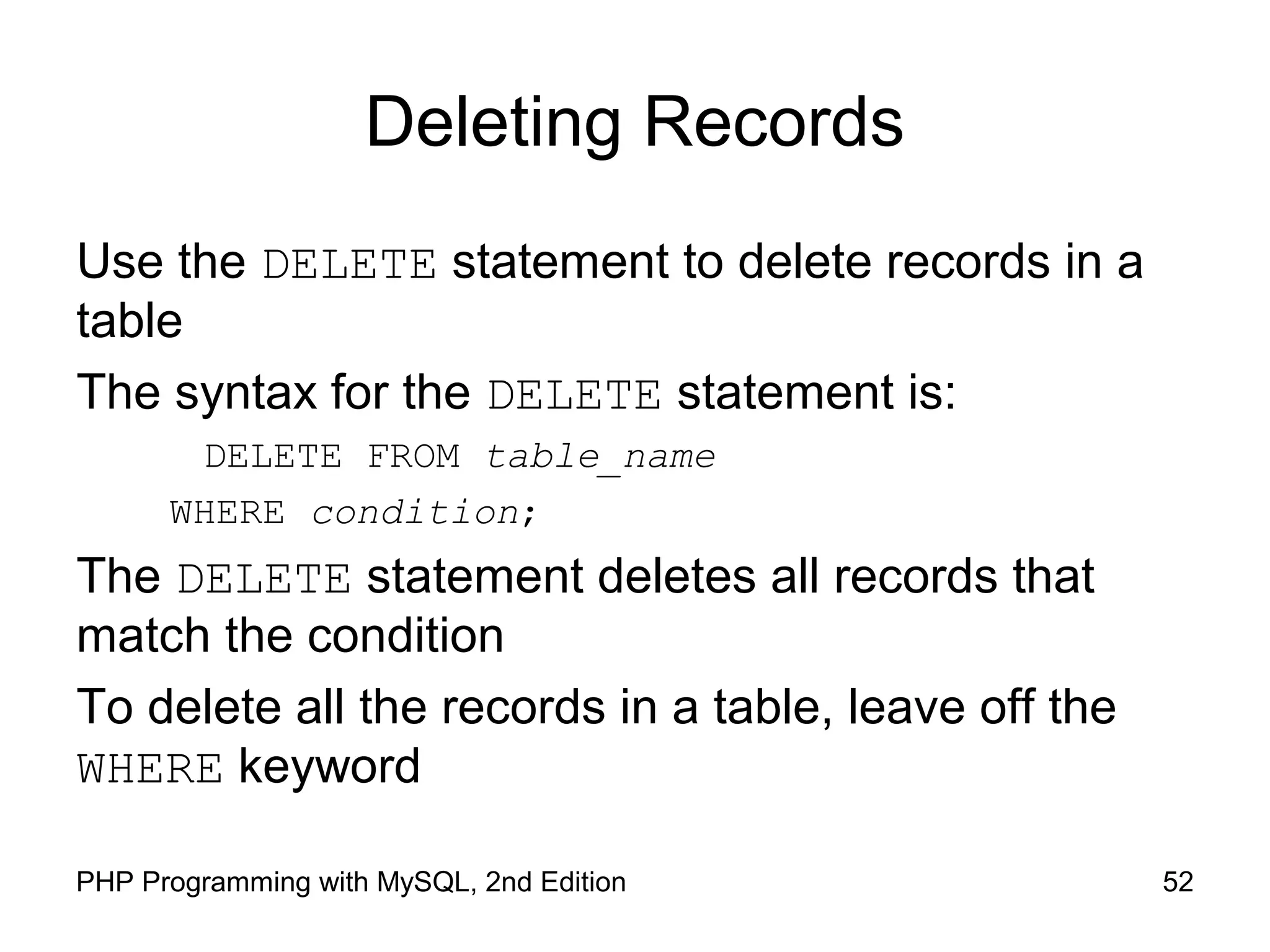
![53PHP Programming with MySQL, 2nd Edition Deleting Records (continued) mysql> DELETE FROM company_cars WHERE model_year=2006 AND make='Honda' AND model='Accord';[ENTER] To delete all records from a table, omit the WHERE clause](https://image.slidesharecdn.com/workingwithdatabasesandmysql-150317100342-conversion-gate01/75/Working-with-Databases-and-MySQL-53-2048.jpg)